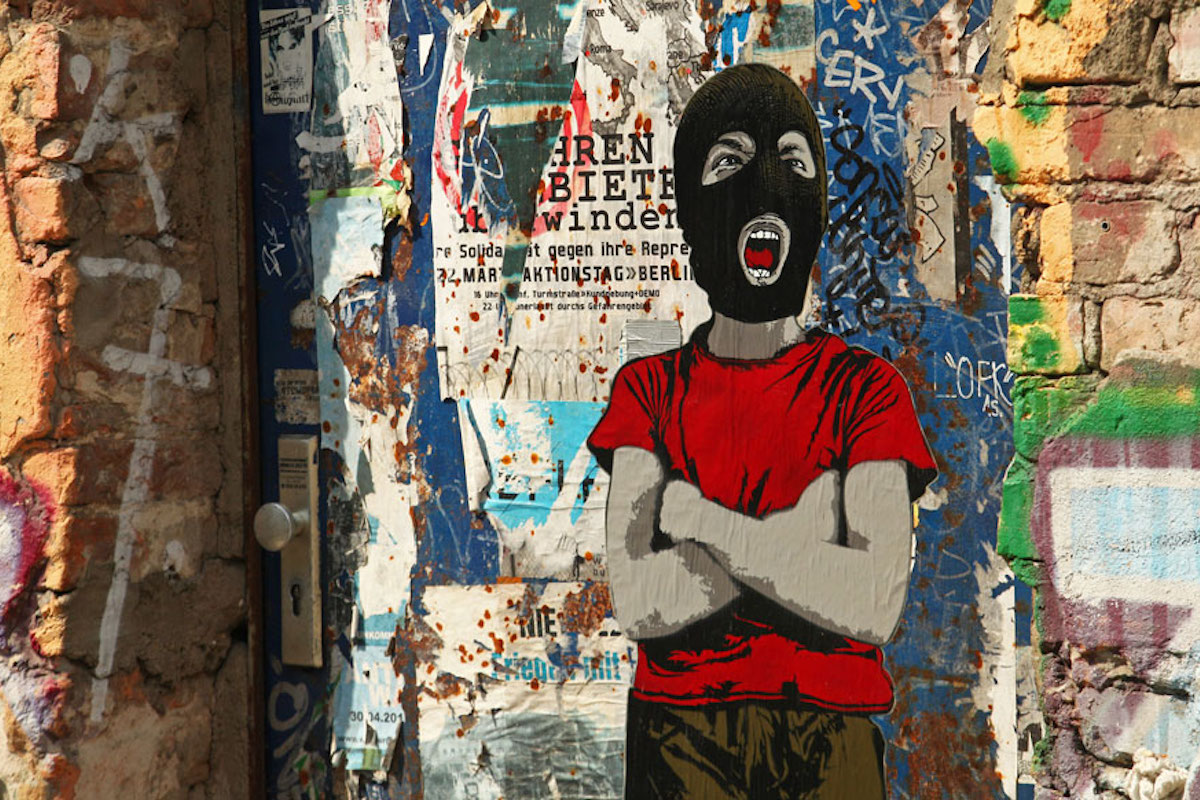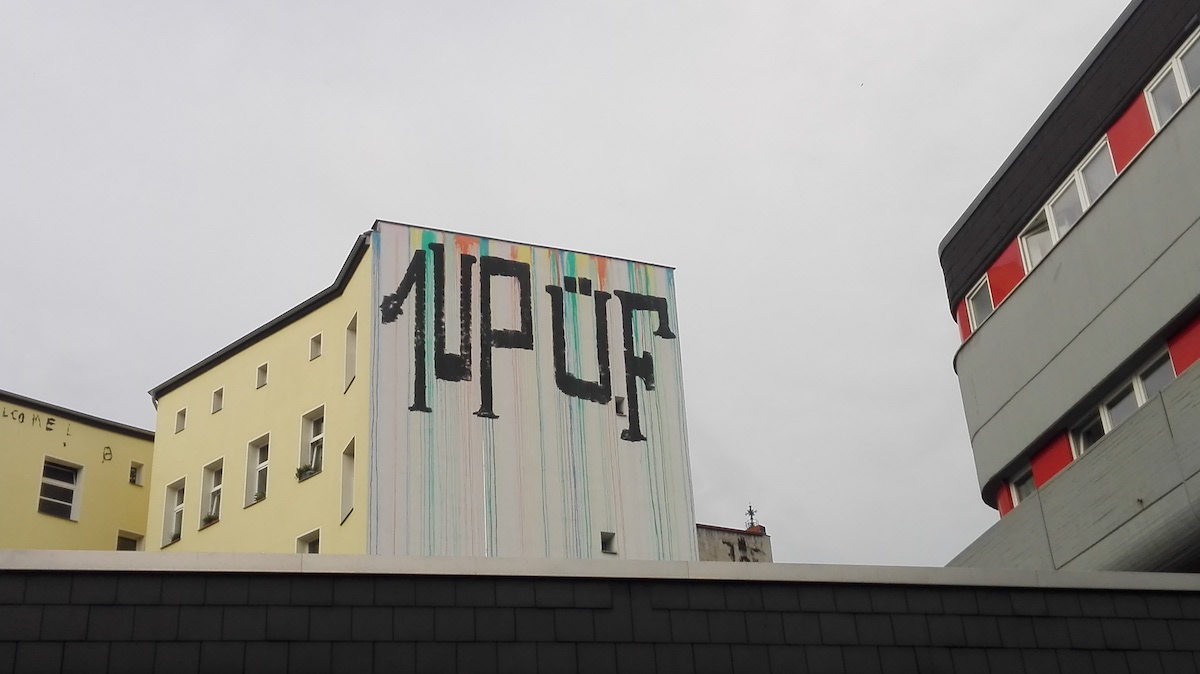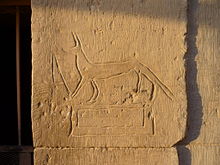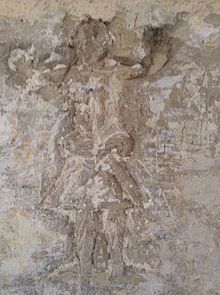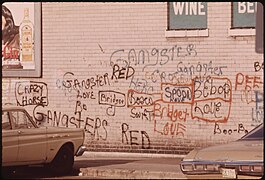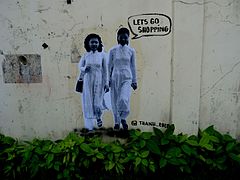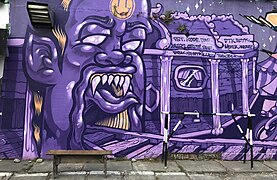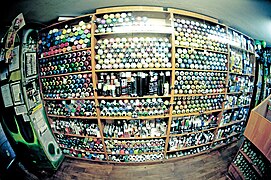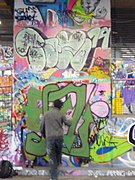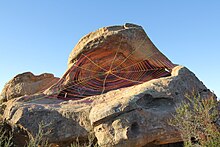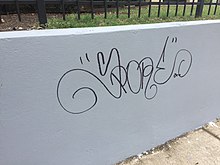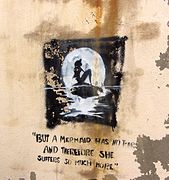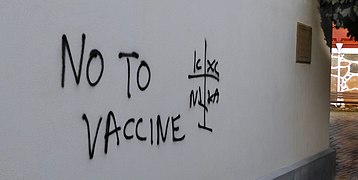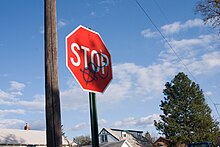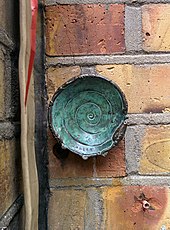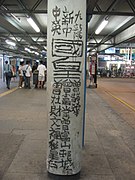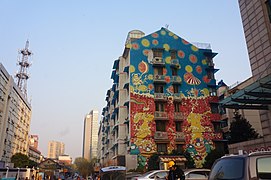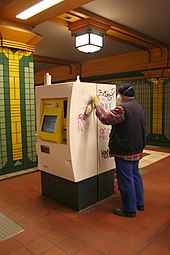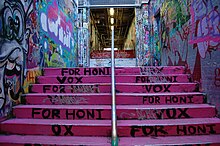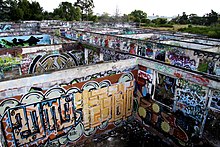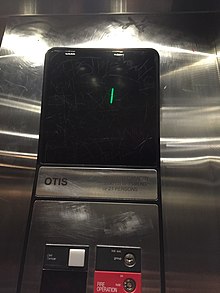
READING PASSAGE 1
You should spend about 20 minutes on Questions 1-13 which are based on Reading Passage 1 below.
GRAFFITI
A
The word ‘graffiti’ derives from the Greek word graphein, meaning to write. This evolved into the Latin word graffito. Graffiti is the plural form of graffito. Simply put, graffiti is a drawing, scribbling or writing on a flat surface. Today, we equate graffiti with the ‘New York’ or ‘Hip Hop’ style which emerged from New York City in the 1970s. Hip Hop was originally an inner-city concept. It evolved from the rap music made in Brooklyn and Harlem in the late 1960s and early 1970s. Donald Clarke, a music historian, has written that rap music was a reaction to the disco music of the period. Disco was centred in the rich, elitist clubs of Manhattan and rap emerged on street corners as an alternative. Using lyrical rhythms and ‘beat boxing’, the music was a way to express feelings about inner-city life. Hip Hop emerged as turntables began to be used to form part of the rhythm by ‘scratching’ (the sound created by running the stylus over the grooves of an LP). As Hip Hop music emerged so did a new outlet for artistic visibility. Keith Haring began using posters to place his uniquely drawn figures and characters in public places. Soon he began to draw directly on subway walls and transit posters. The uniqueness of his drawings eventually led to their being shown in galleries and published in books and his art became ‘legitimate’.
B
At about the same time as Keith Haring, a delivery messenger began writing ‘Taki 183’ whenever he delivered documents. Soon his name was all over the city. Newspapers and magazines wrote articles about him and Keith Haring, and soon both became celebrities. This claim to fame attracted many young people, especially those involved with rapping, and they began to imitate ‘Taki 183’, as a means to indicate the writer’s presence, i.e. the age-old statement of I was here. Graffiti was soon incorporated int the Hip Hop culture and became a sort of triad with rapping and breakdancing. Breakdancing has since lost much of its initial popularity, while rapping has emerged as a major style in American music. New York City was inundated with graffiti during the late seventies and early eighties, but as media coverage faded so did the graffiti. Then, in the mid-eighties, a national TV programme did a graffiti story and set off a graffiti wildfire which has since gone global.
C
In the past, graffiti artists usually worked alone, but the size and complexity of pieces, as well as safety concerns, motivated artists to work together in crews, which are groups of graffitists that vary in membership from 3 to 10 or more persons. A member of a crew can be ‘down with’ (affiliated with) more than one crew. To join a crew, one must have produced stylish pieces and show potential for developing one’s own, unique style. A crew is headed by a king or queen who is usually that person recognised as having the best artistic ability among the members of the crew. One early crew wrote TAG as their crew name, an acronym for Tuff Artists Group. Tag has since come to mean both graffiti writing, ‘tagging’ and graffiti, a ‘tag’. Crews often tag together, writing both the crew tag and their own personal tags. Graffiti has its own language with terms such as piece, toy, wild-style, and racking.
D
At first pens and markets were used, but these were limited as to what types of surfaces they worked on, so very quickly everyone started using spray paint. Spray paint could mark all types of surfaces and be quick and easy to use. However, the spray nozzles on the spray cans proved inadequate to create more colourful pieces. Caps from deodorant, insecticide, and other aerosol cans were substituted to allow for a finer or thicker stream of paint. As municipalities began passing graffiti ordinances outlawing graffiti implements, clever ways of disguising paint implements were devised. Shoe polish, deodorant roll-ons and other seemingly innocent containers were emptied and filled with paint. Markers, art pens and grease pens obtained from art supply stores were also used. In fact, nearly any object which can leave a mark on most surfaces is used by taggers, though the spray can is the medium of choice for most taggers.
E
As graffiti has grown, so too has its character. What began as an urban lower-income protest, graffiti now spans all racial and economic groups. While many inner-city kids are still heavily involved in the graffiti culture, taggers range from the ultra-rich to the ultra-poor. There is no general classification of graffitists. They range in age from 12-30 years old, and there are male and female artists. One tagger recently caught in Philadelphia was a 27-year-old stockbroker who drove to tagging sites in his BMW. Styles have dramatically evolved from the simple cursory style, which is still the most prevalent, to intricate interlocking letter graphic designs with multiple colours called ‘pieces’ (from master-pieces). Gang markings of territory also fit the definition of graffiti, and they mainly consist of tags and messages that provide ‘news’ of happenings in the neighbourhood.
F
Graffiti shops, both retail and on-line, sell a wide variety of items to taggers. Caps, markers, magazines, T-shirts, backpacks, shorts with hidden pockets, even drawing books with templates of different railroad cars can be purchased. Over 25,000 graffiti sites exist on the world wide web; the majority of these are pro-graffiti. Graffiti vandalism is a problem in nearly every urban area in the world. Pro-graffiti web sites post photos of graffiti from Europe, South America, the Philippines, Australia, South Africa, China and Japan. Billions of dollars worldwide are spent each year in an effort to curb graffiti.
G
While most taggers are simply interested in seeing their name is as many places as possible and as visibly as possible, some taggers are more content to find secluded warehouse walls where they can practise their pieces. Some of these taggers are able to sell twelve-foot canvases of their work for upwards of $10 – $12,000. As graffiti was introduced to the art world, two trends happened. One, the art world of collectors, dealers, curators, artists and the like helped graffitists evolve in style, presumably by sharing their artistic knowledge with the newcomers. Two, the exposure helped to expand graffiti into all parts of the world. Furthermore, more progressive cities have recognised the talent of graffitists by providing a means for them to do legal graffiti art, which has helped to foster the art form and lessen the amount of graffiti art that appears in the city as vandalism. Likewise, organisations who support graffiti artists seek out places to do legal graffiti such as abandoned buildings, businesses, or community walls in parks. What this shows is that some graffiti, particularly in the form of a spray can art, is recognised as art by the conventional art world.
Questions 1-7 (Graffiti reading answers ielts)
Reading Passage 1 has seven paragraphs, A-G.
Choose the correct heading for each paragraph from the list of headings below.
Write the correct number i-x in boxes 1-7 on your answer sheet.
i Becoming mainstream art
ii The Culture Of Graffiti
iii Tools Of The Trade
iv Internet Art Styles
v Crossing Boundaries
vi Cashing In On The Craze
vii Trends In Street Music
viii Gradually gaining popularity
ix A Solitary Existence
x From Ancient To Modern
1 Paragraph A
2 Paragraph B
3 Paragraph C
4 Paragraph D
5 Paragraph E
6 Paragraph F
7 Paragraph G
Questions 8-10
Do the following statements agree with the information given in Reading Passage 1?
In boxes 8-10 on your answer sheet, write
TRUE if the statement agrees with the writer’s claims
FALSE if the statement contradicts the writer’s claims
NOT GIVEN if it is impossible to say what the writer thinks about this
8 The introduction of anti-graffiti laws managed to curb its spread in some cities.
9 Along with Hip Hop music came a new way of visual expression.
10 There was hostility towards graffiti artists among the established art community.
Questions 11-13
Complete each sentence with the correct ending A-F below.
Write the correct letter A-F in boxes 11-13 on your answer sheet.
11 Graffiti is flourishing in the 21st century as people from all backgrounds have begun to ……………………….
12 As graffiti has developed, it has come to ……………………….
13 Graffiti artists used many ingenious methods to ……………………..
A use it as a means of expression of rebellion against law enforcement.
B become increasingly more difficult to succeed in the art world.
C transcend race, status and gender.
D realise that inner-urban areas where poverty is the norm are decreasing.
E conceal their intentions from law enforcement officers.
F embrace it as a means of expression.
Answers:- Graffiti reading answers ielts
Passage 1
- x
- viii
- ii
- iii
- v
- vi
- i
- NOT GIVEN
- TRUE
- FALSE
- F
- C
- E
If you enjoyed “Graffiti reading answers ielts”, please share this post and comment on it.
Regards
Er. Nachhattar Singh ( CEO, blogger, youtuber, Motivational speaker)
Home
The purpose of graffiti
Graffiti as a form of artistic expression, often associated with subcultures as the rebel against authority. Graffiti in its origins was used to publicly display the artistic expressions in response to the lack of access to museums and art institutions, and the continuous strife, discrimination, and struggle of living in the city.
Because graffiti is illegal in most cases, this form of art has flourished in the underground, requiring little money and providing an opportunity to voice what is often excluded from dominant histories and media. From here, although graffiti remains the major form of street art with other mediums have evolved — including stenciling, stickers, and wheatpasting.
On the other hand, artists also used graffiti as a tool, to express their political opinions, (indigenous) heritage, cultural and religious imagery, and counter-narratives to dominant portrayals of life in the barrios. Similar to other forms of art within, graffiti has become another tool of resistance, reclamation, and empowerment to make the artist own space for expression and popular education.
Nowadays, graffiti is commonly recognized as a form of public art, embraced by museums, art critics, and art institutions. But its significance for many people remains in the barrios (neighborhoods), reiterating the importance of accessibility and inclusion in relation to their identity and community in their artwork.
Stencil. Alias – Dissitent – Berlin, 2017.
Every art form or art movement have their specific language. We can find many art historical dictionaries or glossaries in any library in virtually every language. Still, one of the biggest art movements – Street Art and Graffiti in a broader sense – has been deprived of its right to have such a lexicon. This is why we embarked on a neverending journey of starting and building a glossary of Street Art and Graffiti words.
Categorizing a complex, differentiated and rich subculture of Street Art and Graffiti is practically impossible, but we tried to group these words into three basic categories – Cultural terms, Styles, and Techniques. Please, be aware that any of the terms can refer to more than one category and that this attempt in classification was done in good faith.
We present you with the ultimate glossary of Graffiti and Street Art, a growing lexicon of terms that we will continue to update.
1UP – ÜF Wiener rainbow graffiti. Heaven spot.- Photo by Katia H.
Cultural terms
Adbusting – Or Subvertising is the practice of altering and making satirical interventions on public, corporate or political advertisements. It’s marked by humor, satire and often sharp criticism of certain societal issues, most often consumerism.
All-city – Gaining this label means to become a famous graffiti writer in the entire city. The term originates from New York, and it used to mean – to be known in all the five boroughs, while this “fame” was spread by the subway.
Angel(s) – a famed and well respected graffiti artist who is no longer alive. Admirers and followers would make tribute portraits of “Angels” or they would tag their names with hovering halos above, adding the dates of their birth and death.
Back to back or End to end – Huge graffiti piece that covers a wall from one end to the other, similar to pieces found on the western side of the Berlin Wall. On a subway train, it refers to a piece that covers the entire train, end to end. Abbreviation – B2B or E2E. Usually painted below the windows of a car, they are sometimes called window-downs.
Bite – To steal someone’s art, ideas, names, tags, letter styles or palette. Often a term related to “toys” (see below).
Black book – A sketchbook of a graffiti artist, a treasured possession. Usually, it’s filled with sketches of new pieces or other writers’ tags, containing the entirety of an artist’s body of work. A document of illegal works, a black book is carefully hidden away from authorities, so it doesn’t become evidence against its author.
Buff – To erase, paint over in one dull color, or otherwise remove graffiti, often with chemicals and pressure guns with sand or water.
Burn – To burn can mean either to make a better piece than a rival artist, or to snitch on someone (on purpose or accidentally). A burner piece is a complicated work that takes a lot of time and effort, a style statement, often legal.
Cannons – Spray cans. Term that probably originates in Brooklyn, NY.
Cap – Or Tips – is the nozzle for the spray paint can. Different types of aerosol caps are used to get different effects or styles, from Thins, Rustos, to Fatcap.
Crew – Also spelled as Cru or Krew, is a group of writers that work together, usually in a similar style. Although crew activity does reflect gang behavior, their prime objective is graffiti and not serious criminal. Crews often engage in large collaborative pieces, but a crew piece can also be executed by anyone in a group. If a single member is arrested, he can be held liable for a joint work.
Culture jamming – The act of subverting media culture and mainstream cultural marketing according to the principles of anti-consumerist social movements. A form of subvertising or adbusting, usually with a distinctively political purpose.
Deface / Cap / Go over – To ruin another artist’s piece. A writer named “Cap” would rudely make throw ups over existing graffiti, giving a name to this infamous practice.
Going over a piece is the ultimate sign of disrespect and represents a declaration of graffiti war. Still, there is a hierarchy of styles in which case going over can be tolerated. Usually, it means that low quality work is OK to be painted over with something better. The other way around is generally unacceptable.
Dress-up – To paint over a specific enclosed are entirely – to completely change a shop window or a doorway that has previously been graffiti-free.
Fatcap – A wide spray can nozzle, that covers a wide area at once, used to fill in the pieces.
German Montana – A brand specializing in graffiti-related products, such as spray cans etc. Not related to Spanish Montana, a company that came up with the idea first. The two companies had a dispute over the name.
Ghost – A paint stain that is left after a graffiti work has been badly buffed.
Hat (honor among thieves) – For an artist with a solid reputation in the graffiti community, a trusted member who does not snitch, is said that he’s wearing a “hat”.
Head / King – Head is a highly respected writer in a certain area, similar to King or Queen. Kings or Queens are graffiti artists that are famous among other writers for their skill, style or courage. Self-proclaimed kings often paint crowns into their work, but this practice is risky because their claim must be valid in the eyes of the others. Usually, kings or queens are declared by other kings or queens.
Heaven spot (Heavens) – Challenging pieces of graffiti painted in places that are almost impossible to reach and require a significant level of acrobatics. Painting in heaven spots can lead to injury or death (they can ‘hit up heavens’), which only contributes to the reputation of the writer. Furthermore, heavens are also rather difficult to remove.
Hip-hop – Late 70s and early 70s culture marked by early rap music, breakdancing and visual style that gave birth to the graffiti culture.
Invisible – A rare and symbolic form of graffiti that represents only quickly sketched logos.
Krylon – A brand of spray paint, once popular with writers, heavily used in the 70s and 80s. A sign of graffiti nostalgia, known for its 5-spot logo. Despite a new line of paint issued in 2008, it’s considered that only a toy would use a 360 krylon, the cheapest variation of the spray can. The first line of paint, “original krylon”, is considered a collectors’ item.
Landmark – A graffiti piece executed in a location that is hard to reach or hidden, difficult to buff, generally in place for at least 5 years. Usually marked with a date of painting. These works are held in high regard by the writers.
Legal wall – A piece that is made legalley, with permission from the wall owner or the authorities. Only a testified illegal writers can get respect for legal walls.
Lock on – Sculpture in public spaces, generally locked or chained to public fittings such as light posts and similar. It’s non-destructive, installation-type of art.
Married couple – A vintage subway term originating from New York, signifying two subway cars that are permanently tied to each other. In graffiti, it means two whole cars painted next to each other, sometimes with a painting being connected across the gap – a sign of the “marriage”.
Moniker – A street name of an artist, their nickname and label.
Pichação – Celebrated style of graffiti created in Sao Paulo, Brazil. Created by the misfits as a form of social protest, these works bear considerable risk, being painted in hard-to-reach places. More popular for its meaning than for its stylistic qualities.
Post-graffiti – A generic, recent term that includes everything that could be seen as Street Art.
Rooftop – Heaven graffiti painted on rooftops.
Rook – A trustworthy crew member.
Run – Time that a graffiti piece spends on a surface without being removed, duration of a piece. “It run for a year” can be said.
Slam – To do graffiti in a very public or otherwise risky location.
Slash – To cross-out or to tag over a piece of another writer. A serious insult – same as Cap.
Spanish Montana – A brand specializing in graffiti-related products, such as spray cans etc. Not related to German Montana, a company of the same name that followed the steps of Spanish Montana. The two companies had a dispute over the name.
Toy – A word describing either poor work or a painter without skill, sometimes a newbie. “To toy” someone else’s graffiti means to go over it. An acronym meaning “tag over your shit”, often placed on top of bad, or “toy” work.
Tree – Graffiti that is chiseled into a tree bark.
Undersides – Graffiti painted on the underside of a subway or train car. Often lasts longer than the usual train tag, because it’s spotted later and not as visible.
Whole car/ whole train – A large graffiti piece executed by one or multiple writers that covers the entire outside surface of a train car. Whole train graffiti covers the entirety of a train.
Difficult to paint, these works are more often collaborative, done in limited amounts of time (often under 5 minutes) with limited color schemes. If successful, this is one of the most respected graffiti forms out there.
Writer – A graffiti artist.
Wildstyle piece on Berlin U8 – Photo by Katia H.
Styles
3D Style – An effect used on basic graffiti letters to add an illusion of a third dimension. The first artist who started embellishing letters in this way is Phase 2. In graffiti culture, 3D refers to letter writing, but there is another version of 3D painting on pavement that is very popular called Chalk art. Chalk art and 3D graffiti are very different in both concept and aesthetics and they are not to be mixed.
Abstract Style – Letters are generally not a part of the Abstract style, but the painterly skill and harmony an artist demonstrates in a piece. The goal is similar to abstract painting – to make a harmonious piece with specific dynamics and balance by the use of basic artistic elements – line, shape, geometry, color and composition.
Anti-Style / Ugly Style – Also known as “ghetto style” or “ignorant style”. A deliberately toy or seemingly unskilled style of writing and painting. It stems from the 70s graffiti culture in New York, but it spread gaining popularity in the 80s and early 90s in San Francisco. Anti-style does not follow any rules and is highly individualized, but often visually awkward. We can see examples of this type of painting in San Francisco, New York, Paris, Berlin and other bigger cities in Europe.
Backjump – A throw-up or a panel piece that is executed quickly, often on a momentarily parked train or bus.
Blockbuster Style – Blockbuster or “straight” letters are big, square, robust and simple. More readable than most graffiti, they are usually painted in two colors, often combinations of plain black, white and silver. Used to go over other work, or to cover train sides more easily, blockbusters are good for supreme coverage.
Bombing – An act of painting many different walls inside one city area or train within a very short timeframe. To “hit”. Graffiti bombers are prone to using simpler styles, tags or throw-ups, because speed is an important factor. It can also mean – to go out writing.
Bubble Style – An old, a bit dated graffiti style of simple, rounded, bubble-shaped letters, generally easy to read. Throw-ups are often painted in this style, because it’s easy and quick to execute.
Cartoon / Character – A widely recognized cartoon or a character figure often borrowed from comics, popular culture or TV. Writers dedicated to cartoons often invent their own characters and imagery. Cartoon graffiti adds humor to a piece, easily adapted to the most of the lettering styles.
Challenge (Insides) – Challenge graffiti is made to mark that somebody “was there”. Just like insides, it’s often painted indoors. Insides are a more specific reference to tags written inside public transportation vehicles – trains, busses etc.
Complex Style – A generic term for graffiti that uses complicated lettering, an abundance of color and that is hard to execute. These works are difficult to read, but they are visually impressive.
Dubs (UK) – Graffiti executed in silver or chrome paint, originating from London, UK. They can be found around railway stations or in the streets. Dubs are usually a crew effort.
Free Style – A combination of styles without one defining characteristic. An individual expression.
Full Monty – A piece that covers an entire area, wall or object. It can contain a coarse, but a highly effective message.
Mop – A homemade graffiti painting tool. Usually used to paint larger tags. It has a rounded tip and leaves a fat line that drips. Mops can be done in different paints.
Mural – A wall painting applied on either outside or an inside surface, or a ceiling. In street art, it refers to a large, elaborate wall piece that requires significant skill to paint. Unlike graffiti, murals normally respect the architecture of the wall and the building, sometimes even the surroundings. They are often legal.
Old School – A generic term that refers to the times of early graffiti, to the 70s and early 80s. It can relate to the hip-hop music of that period as well. Old-school writers enjoy a lot of respect because they were there from the beginning, many of them having invented particular styles of writing. For example, Phase 2 created bubbles, clouds and 3D, and Blade and Comet started using blockbusters first.
Own Style – A style characteristic for one specific writer.
Piece (free-hand) – Short for “masterpiece”, painted free-hand. A big and complex piece of wall painting that is time-consuming and difficult to execute. It’s characterised by many different components, such as rich palette, 3D elements, and other visual marks. A work of a more experienced writer, earning them extra respect.
Punition – A type of graffiti writing in which one word is repeated countless times, until it covers an entire surface. The name comes from the punition lines used to punish children at school.
Roller graffiti – Graffiti that is painted with a roller and paint, rather than with a spray can. There are special techniques related to this type of writing.
Semi-Wildstyle – A simpler form of Wildstyle, more discernible than the full-on wildstyle writing.
Sharp – A manner of writing very geometric, angular letters with lost of sharp angles and corners, taking the pointy and piercing elements to an extreme. Letters are altered greatly,often unrecognizable, giving off a fierce and furious impression.
Tag – A signature of a writer, very stylized, written quickly, usually in one color that contrasts the background. Denotes the artist’s moniker. The simplest and the most common type of graffiti. Used as a verb, “to tag” means “to sign”, which derives from a classical practice of artists signing their works.
Tagging – To write tags. An accepted term in today’s pop culture, often meaning something other than graffiti writing. After it first appeared in Philadelphia with messages Bobby Beck was leaving around city’s freeways, tagging has evolved in many different ways. Different manners of tagging can be found in different cities, often depending on the region and local culture, and naturally, the artist himself. New York tag writer of the early 70s, TAKI 183 is considered one of the forefathers of graffiti and tagging in general.
Throw-up – Sometimes called a “throwie” is a simple form of graffiti, sitting between a tag and a bomb. It’s usually painted with a simple letter outline and then filled with color. Hollow throw-ups are called “Hollows”, while painted are known as “Fill-ins”. Throw-ups are often made in bubble or blockbuster style that support quick execution. Artists would use throw-ups and tags to cover as many surfaces as possible, competing with their rivals. These graffiti works are stylistically defined and recognizable, unlike pieces that are more liberated and painterly. Along with a tag, a throw-up is an artist’s logo.
Wildstyle – Very complex and highly stylized form of lettering that is often impossible to read by non-writers. The letters can get so complicated, borderline abstract, containing 3D elements, with a lot of connections, arrows, and interlocking. Generally, wildstyle is seen as one of the most demanding graffiti writing styles, reserved only for those with serious skill.
Tags. Xoooox is among them. – Photo by Katia H.
Techniques
Domming -A spray-painting color mixing technique where one color is sprayed over another wet layer and the two nuances are then rubbed together. An abrasive tool, such as sand or sandpaper, can be used to create effects in domming. The term derives from the word “condom”, synonymous to “rubber”. Sometimes referred to as “fingering”, because it’s executed with fingers.
Etching – In graffiti, it refers to the use of acid solutions to create frosted glass (Etch Bath), to write on windows. Potentially hazardous. In Norway, there were trains taken off the rails because of the danger these solutions posed for public health.
Extinguisher bombing – To do graffiti with a fire extinguisher filled with paint. This technique can cover large surfaces, but it leaves a fat, messy, dripping line and it’s not suitable for fine work.
Fading – An aerosol color blending technique.
Fill-ins – A term denoting the painted interior of letters, throw-ups or pieces, usually in a single, solid color.
Installation – An art genre of three-dimensional, site-specific works that are usually created having that particular locale in mind. They can be executed in the interior or in the exterior. Exterior installations fall into the domain of public art, land art, public interventions or street art, although these art forms often overlap.
Outlining – Making a sketch or a preparatory drawing, done on paper or in a black book while planning a piece. An outline can also refer to a wall sketch, or to the contour of a throw-up or similar graffiti work, a boundary that can be filled.
Poster – A paper-based work created in the studio that can be wheat-pasted onto a wall. Following a long and rich history of poster art, graffiti culture has taken this easy and effective public expression tool and transformed it into one of the most favored paste-up formats.
Scriber – A scribing or scratching tool. An instrument tipped with a ceramic or a diamond drill bit, used to engrave a tag into a surface, usually inside a public vehicle. A destructive tool.
Scribing / Scratching -Also known as “scratchitti”, scribing is a destructive technique of hand-engraving or scratching a tag into a surface. It can be done using a simple key, knife or sand paper, although scribing pros use a Scriber.
Stencil – One of the most popular form of street art. Stencil pieces are made with stencils made out of cardboard, paper and other materials that help create a nice, figurative image quickly and well. The pre-prepared design is cut out and then transferred onto a wall with a spray or roll-on paint. Easily repeated on different walls. Multiple layers of stencils can create very beautiful and elaborate images, allowing the use of a lot of colors and details.
Sticker – Stickers are used to bomb, slap or tag a surface or an area without writing. Graffiti stickers are usually designed and printed well ahead, containing traits of an artist’s style as well as his message. Sticker messages often contain political or social critique, referring to a specific issue. Many brands produce their own stickers.
Wheatpasting / Paste-up – Wheat paste or flour paste is an adhesive made of flour or starch and water. It’s used to glue paper-based images to a wall, giving a name to a street art technique. Many artists who create their paper-based works in the studio engage in wheatpasting when they distribute their pieces around an area. These works can be simple or complex, depending on an individual artist. Works made and installed this way are called paste-ups. The technique is quick and easy to execute in the street, although each piece can take a lot of time to invent and prepare in the studio, showing the artistic mastery of its author.
Yarn bombing – A recent type of street art activity that makes use of crocheted or knitted colorful yarn coverings, thrown on different parts of public furniture such as sculptures, fences, light posts, monuments etc. It’s also known as guerrilla knitting, urban knitting, or yarn storming.
A bat stencil – Author unknown – Photo by Katia H.
Graffiti (plural; singular graffiti or graffito, the latter rarely used except in archeology) is art that is written, painted or drawn on a wall or other surface, usually without permission and within public view.[1][2] Graffiti ranges from simple written words to elaborate wall paintings, and has existed since ancient times, with examples dating back to ancient Egypt, ancient Greece, and the Roman Empire (see also mural).[3]
Graffiti is a controversial subject. In most countries, marking or painting property without permission is considered by property owners and civic authorities as defacement and vandalism, which is a punishable crime, citing the use of graffiti by street gangs to mark territory or to serve as an indicator of gang-related activities.[4] Graffiti has become visualized as a growing urban «problem» for many cities in industrialized nations, spreading from the New York City subway system and Philadelphia in the early 1970s to the rest of the United States and Europe and other world regions.[5]
Etymology
«Graffiti» (usually both singular and plural) and the rare singular form «graffito» are from the Italian word graffiato («scratched»).[6][1][2] The term «graffiti» is used in art history for works of art produced by scratching a design into a surface. A related term is «sgraffito»,[7] which involves scratching through one layer of pigment to reveal another beneath it. This technique was primarily used by potters who would glaze their wares and then scratch a design into it. In ancient times graffiti were carved on walls with a sharp object, although sometimes chalk or coal were used. The word originates from Greek γράφειν—graphein—meaning «to write».[8]
History
Figure graffito, similar to a relief, at the Castellania, in Valletta
The term graffiti originally referred to the inscriptions, figure drawings, and such, found on the walls of ancient sepulchres or ruins, as in the Catacombs of Rome or at Pompeii. Use of the word has evolved to include any graphics applied to surfaces in a manner that constitutes vandalism.[9]
The only known source of the Safaitic language, an ancient form of Arabic, is from graffiti: inscriptions scratched on to the surface of rocks and boulders in the predominantly basalt desert of southern Syria, eastern Jordan and northern Saudi Arabia. Safaitic dates from the first century BC to the fourth century AD.[10][11]
Modern-style graffiti
The first known example of «modern style»[clarification needed] graffiti survives in the ancient Greek city of Ephesus (in modern-day Turkey). Local guides say it is an advertisement for prostitution. Located near a mosaic and stone walkway, the graffiti shows a handprint that vaguely resembles a heart, along with a footprint, a number, and a carved image of a woman’s head.
The ancient Romans carved graffiti on walls and monuments, examples of which also survive in Egypt. Graffiti in the classical world had different connotations than they carry in today’s society concerning content. Ancient graffiti displayed phrases of love declarations, political rhetoric, and simple words of thought, compared to today’s popular messages of social and political ideals.[12]
The eruption of Vesuvius preserved graffiti in Pompeii, which includes Latin curses, magic spells, declarations of love, insults, alphabets, political slogans, and famous literary quotes, providing insight into ancient Roman street life. One inscription gives the address of a woman named Novellia Primigenia of Nuceria, a prostitute, apparently of great beauty, whose services were much in demand. Another shows a phallus accompanied by the text, mansueta tene («handle with care»).
Disappointed love also found its way onto walls in antiquity:
Quisquis amat. veniat. Veneri volo frangere costas
fustibus et lumbos debilitare deae.
Si potest illa mihi tenerum pertundere pectus
quit ego non possim caput illae frangere fuste?Whoever loves, go to hell. I want to break Venus’s ribs
with a club and deform her hips.
If she can break my tender heart
why can’t I hit her over the head?— CIL IV, 1824.[13]
Ancient tourists visiting the 5th-century citadel at Sigiriya in Sri Lanka scribbled over 1800 individual graffiti there between the 6th and 18th centuries. Etched on the surface of the Mirror Wall, they contain pieces of prose, poetry, and commentary. The majority of these visitors appear to have been from the elite of society: royalty, officials, professions, and clergy. There were also soldiers, archers, and even some metalworkers. The topics range from love to satire, curses, wit, and lament. Many demonstrate a very high level of literacy and a deep appreciation of art and poetry.[14] Most of the graffiti refer to the frescoes of semi-nude females found there. One reads:
Wet with cool dew drops
fragrant with perfume from the flowers
came the gentle breeze
jasmine and water lily
dance in the spring sunshine
side-long glances
of the golden-hued ladies
stab into my thoughts
heaven itself cannot take my mind
as it has been captivated by one lass
among the five hundred I have seen here.[15]
Among the ancient political graffiti examples were Arab satirist poems. Yazid al-Himyari, an Umayyad Arab and Persian poet, was most known for writing his political poetry on the walls between Sajistan and Basra, manifesting a strong hatred towards the Umayyad regime and its walis, and people used to read and circulate them very widely.[16][clarification needed]
Level of literacy often evident in graffiti
Historic forms of graffiti have helped gain understanding into the lifestyles and languages of past cultures. Errors in spelling and grammar in these graffiti offer insight into the degree of literacy in Roman times and provide clues on the pronunciation of spoken Latin. Examples are CIL IV, 7838: Vettium Firmum / aed[ilem] quactiliar[ii] [sic] rog[ant]. Here, «qu» is pronounced «co». The 83 pieces of graffiti found at CIL IV, 4706-85 are evidence of the ability to read and write at levels of society where literacy might not be expected. The graffiti appear on a peristyle which was being remodeled at the time of the eruption of Vesuvius by the architect Crescens. The graffiti were left by both the foreman and his workers. The brothel at CIL VII, 12, 18–20 contains more than 120 pieces of graffiti, some of which were the work of the prostitutes and their clients. The gladiatorial academy at CIL IV, 4397 was scrawled with graffiti left by the gladiator Celadus Crescens (Suspirium puellarum Celadus thraex: «Celadus the Thracian makes the girls sigh.»)
Another piece from Pompeii, written on a tavern wall about the owner of the establishment and his questionable wine:
Landlord, may your lies malign
Bring destruction on your head!
You yourself drink unmixed wine,
Water [do you] sell [to] your guests instead.[17]
It was not only the Greeks and Romans who produced graffiti: the Maya site of Tikal in Guatemala contains examples of ancient Maya graffiti. Viking graffiti survive in Rome and at Newgrange Mound in Ireland, and a Varangian scratched his name (Halvdan) in runes on a banister in the Hagia Sophia at Constantinople. These early forms of graffiti have contributed to the understanding of lifestyles and languages of past cultures.
Graffiti, known as Tacherons, were frequently scratched on Romanesque Scandinavian church walls.[18]
When Renaissance artists such as Pinturicchio, Raphael, Michelangelo, Ghirlandaio, or Filippino Lippi descended into the ruins of Nero’s Domus Aurea, they carved or painted their names and returned to initiate the grottesche style of decoration.[19][20]
There are also examples of graffiti occurring in American history, such as Independence Rock, a national landmark along the Oregon Trail.[21]
Later, French soldiers carved their names on monuments during the Napoleonic campaign of Egypt in the 1790s.[22] Lord Byron’s survives on one of the columns of the Temple of Poseidon at Cape Sounion in Attica, Greece.[23]
- Ancient graffiti
-
Ironic wall inscription commenting on boring graffiti
-
-
-
Crusader graffiti in the Church of the Holy Sepulchre
-
-
Contemporary graffiti
Contemporary graffiti art has its origins with young people in 1970s New York. They would use spray paint and other kind of materials to create an image on the sides of buildings and subway trains. [24] While the art was a form of masterpiece, it was also causing problems on subways due to the fact that people could not look out of the widows because they were covered in tags.[25] To the people doing the tags it was to them a form of writing it was not until a novelist named Norman Mailer called it «Graffiti» in The New York Times.[25] During this time period (the late 70s), a war against graffiti broke out, making it so graffitist cannot tag subway trains without getting in trouble anymore, so they moved on to tagging rooftops and canvases.[25] However, today graffitist are paid thousands of dollars to put there artwork on buildings and on canvases to display the amazing works that the artist has done.[26]
Contemporary graffiti style has been heavily influenced by hip hop culture[27] and the myriad international styles derived from Philadelphia and New York City Subway graffiti, however, there are many other traditions of notable graffiti in the twentieth century. Graffiti have long appeared on building walls, in latrines, railroad boxcars, subways, and bridges.
The oldest known example of modern graffiti are the «monikers» found on traincars created by hobos and railworkers since the late 1800s. The Bozo Texino monikers were documented by filmmaker Bill Daniel in his 2005 film, Who is Bozo Texino?.[28][29]
Some graffiti have their own poignancy. In World War II, an inscription on a wall at the fortress of Verdun was seen as an illustration of the US response twice in a generation to the wrongs of the Old World:[30][31]
Austin White – Chicago, Ill – 1918
Austin White – Chicago, Ill – 1945
This is the last time I want to write my name here.
During World War II and for decades after, the phrase «Kilroy was here» with an accompanying illustration was widespread throughout the world, due to its use by American troops and ultimately filtering into American popular culture. Shortly after the death of Charlie Parker (nicknamed «Yardbird» or «Bird»), graffiti began appearing around New York with the words «Bird Lives».[32] The student protests and general strike of May 1968 saw Paris bedecked in revolutionary, anarchistic, and situationist slogans such as L’ennui est contre-révolutionnaire («Boredom is counterrevolutionary») expressed in painted graffiti, poster art, and stencil art. At the time in the US, other political phrases (such as «Free Huey» about Black Panther Huey Newton) became briefly popular as graffiti in limited areas, only to be forgotten. A popular graffito of the early 1970s was «Dick Nixon Before He Dicks You», reflecting the hostility of the youth culture to that US president.
- World War II graffiti
-
Soldier with tropical fantasy graffiti (1943–1944)
-
Advent of aerosol paint
Rock and roll graffiti is a significant subgenre. A famous graffito of the twentieth century was the inscription in London reading «Clapton is God» in reference to the guitarist Eric Clapton. Creating the cult of the guitar hero, the phrase was spray-painted by an admirer on a wall in an Islington, north London in the autumn of 1967.[33] The graffito was captured in a photograph, in which a dog is urinating on the wall.[34]
Graffiti also became associated with the anti-establishment punk rock movement beginning in the 1970s. Bands such as Black Flag and Crass (and their followers) widely stenciled their names and logos, while many punk night clubs, squats, and hangouts are famous for their graffiti.
- Early spray-painted graffiti
-
Graffiti in Chicago (1973)
Spread of hip hop culture
Style Wars depicted not only famous graffitists such as Skeme, Dondi, MinOne, and ZEPHYR, but also reinforced graffiti’s role within New York’s emerging hip-hop culture by incorporating famous early break-dancing groups such as Rock Steady Crew into the film and featuring rap in the soundtrack. Although many officers of the New York City Police Department found this film to be controversial, Style Wars is still recognized as the most prolific film representation of what was going on within the young hip hop culture of the early 1980s.[35] Fab 5 Freddy and Futura 2000 took hip hop graffiti to Paris and London as part of the New York City Rap Tour in 1983.[36]
Stencil graffiti emerges
This period also saw the emergence of the new stencil graffiti genre. Some of the first examples were created in 1981 by graffitists Blek le Rat in Paris, in 1982 by Jef Aerosol in Tours (France);[citation needed] by 1985 stencils had appeared in other cities including New York City, Sydney, and Melbourne, where they were documented by American photographer Charles Gatewood and Australian photographer Rennie Ellis.[37]
Commercialization and entrance into mainstream pop culture
With the popularity and legitimization of graffiti has come a level of commercialization. In 2001, computer giant IBM launched an advertising campaign in Chicago and San Francisco which involved people spray painting on sidewalks a peace symbol, a heart, and a penguin (Linux mascot), to represent «Peace, Love, and Linux.» IBM paid Chicago and San Francisco collectively US$120,000 for punitive damages and clean-up costs.[38][39]
In 2005, a similar ad campaign was launched by Sony and executed by its advertising agency in New York, Chicago, Atlanta, Philadelphia, Los Angeles, and Miami, to market its handheld PSP gaming system. In this campaign, taking notice of the legal problems of the IBM campaign, Sony paid building owners for the rights to paint on their buildings «a collection of dizzy-eyed urban kids playing with the PSP as if it were a skateboard, a paddle, or a rocking horse».[39]
Advocates
Marc Ecko, an urban clothing designer, has been an advocate of graffiti as an art form during this period, stating that «Graffiti is without question the most powerful art movement in recent history and has been a driving inspiration throughout my career.»[40]
Graffiti have become a common stepping stone for many members of both the art and design communities in North America and abroad. Within the United States graffitists such as Mike Giant, Pursue, Rime, Noah, and countless others have made careers in skateboard, apparel, and shoe design for companies such as DC Shoes, Adidas, Rebel8, Osiris, or Circa[41] Meanwhile, there are many others such as DZINE, Daze, Blade, and The Mac who have made the switch to being gallery artists, often not even using their initial medium, spray paint.[41]
Global developments
South America
Tristan Manco wrote that Brazil «boasts a unique and particularly rich, graffiti scene … [earning] it an international reputation as the place to go for artistic inspiration.» Graffiti «flourishes in every conceivable space in Brazil’s cities.» Artistic parallels «are often drawn between the energy of São Paulo today and 1970s New York.» The «sprawling metropolis,» of São Paulo has «become the new shrine to graffiti;» Manco alludes to «poverty and unemployment … [and] the epic struggles and conditions of the country’s marginalised peoples,» and to «Brazil’s chronic poverty,» as the main engines that «have fuelled a vibrant graffiti culture.» In world terms, Brazil has «one of the most uneven distributions of income. Laws and taxes change frequently.» Such factors, Manco argues, contribute to a very fluid society, riven with those economic divisions and social tensions that underpin and feed the «folkloric vandalism and an urban sport for the disenfranchised,» that is South American graffiti art.[42]
A graffiti piece found in Tel Aviv by the artist DeDe
Prominent Brazilian graffitists include Os Gêmeos, Boleta, Nunca, Nina, Speto, Tikka, and T.Freak.[43] Their artistic success and involvement in commercial design ventures[44] has highlighted divisions within the Brazilian graffiti community between adherents of the cruder transgressive form of pichação and the more conventionally artistic values of the practitioners of grafite.[45]
Middle East
Graffiti in the Middle East has emerged slowly, with taggers operating in Egypt, Lebanon, the Gulf countries like Bahrein or the United Arab Emirates,[46] Israel, and in Iran. The major Iranian newspaper Hamshahri has published two articles on illegal writers in the city with photographic coverage of Iranian artist A1one’s works on Tehran walls. Tokyo-based design magazine, PingMag, has interviewed A1one and featured photographs of his work.[47] The Israeli West Bank barrier has become a site for graffiti, reminiscent in this sense of the Berlin Wall. Many graffitists in Israel come from other places around the globe, such as JUIF from Los Angeles and DEVIONE from London. The religious reference «נ נח נחמ נחמן מאומן» («Na Nach Nachma Nachman Meuman») is commonly seen in graffiti around Israel.
Graffiti has played an important role within the street art scene in the Middle East and North Africa (MENA), especially following the events of the Arab Spring of 2011 or the Sudanese Revolution of 2018/19.[48] Graffiti is a tool of expression in the context of conflict in the region, allowing people to raise their voices politically and socially. Famous street artist Banksy has had an important effect in the street art scene in the MENA area, especially in Palestine where some of his works are located in the West Bank barrier and Bethlehem.[49]
Southeast Asia
There are also a large number of graffiti influences in Southeast Asian countries that mostly come from modern Western culture, such as Malaysia, where graffiti have long been a common sight in Malaysia’s capital city, Kuala Lumpur. Since 2010, the country has begun hosting a street festival to encourage all generations and people from all walks of life to enjoy and encourage Malaysian street culture.[50]
- Graffiti around the world
-
-
-
Characteristics of common graffiti
Methods and production
The modern-day graffitists can be found with an arsenal of various materials that allow for a successful production of a piece.[51] This includes such techniques as scribing. However, spray paint in aerosol cans is the number one medium for graffiti. From this commodity comes different styles, technique, and abilities to form master works of graffiti. Spray paint can be found at hardware and art stores and comes in virtually every color.
Stencil graffiti is created by cutting out shapes and designs in a stiff material (such as cardboard or subject folders) to form an overall design or image. The stencil is then placed on the «canvas» gently and with quick, easy strokes of the aerosol can, the image begins to appear on the intended surface.
- Graffiti making
-
The first graffiti shop in Russia was opened in 1992 in Tver
-
Graffiti application at Eurofestival in Turku, Finland
-
Graffiti application in India using natural pigments (mostly charcoal, plant saps, and dirt)
-
A graffiti artist at work in London
Modern experimentation
Spiderweb Yarnbomb Installation by Stephen Duneier both hides and highlights previous graffiti.
Modern graffiti art often incorporates additional arts and technologies. For example, Graffiti Research Lab has encouraged the use of projected images and magnetic light-emitting diodes (throwies) as new media for graffitists. Yarnbombing is another recent form of graffiti. Yarnbombers occasionally target previous graffiti for modification, which had been avoided among the majority of graffitists.
Tagging
Tagging is the practice of someone spray-painting «their name, initial or logo onto a public surface».[52]
A tag in Dallas, reading «Spore»
A number of recent examples of graffiti make use of hashtags.[53][54]
Densely-tagged parking area in Århus, Denmark
Uses
Theories on the use of graffiti by avant-garde artists have a history dating back at least to the Asger Jorn, who in 1962 painting declared in a graffiti-like gesture «the avant-garde won’t give up».[55]
Many contemporary analysts and even art critics have begun to see artistic value in some graffiti and to recognize it as a form of public art. According to many art researchers, particularly in the Netherlands and in Los Angeles, that type of public art is, in fact an effective tool of social emancipation or, in the achievement of a political goal.[56]
In times of conflict, such murals have offered a means of communication and self-expression for members of these socially, ethnically, or racially divided communities, and have proven themselves as effective tools in establishing dialog and thus, of addressing cleavages in the long run. The Berlin Wall was also extensively covered by graffiti reflecting social pressures relating to the oppressive Soviet rule over the GDR.
Many artists involved with graffiti are also concerned with the similar activity of stenciling. Essentially, this entails stenciling a print of one or more colors using spray-paint. Recognized while exhibiting and publishing several of her coloured stencils and paintings portraying the Sri Lankan Civil War and urban Britain in the early 2000s, graffitists Mathangi Arulpragasam, aka M.I.A., has also become known for integrating her imagery of political violence into her music videos for singles «Galang» and «Bucky Done Gun», and her cover art. Stickers of her artwork also often appear around places such as London in Brick Lane, stuck to lamp posts and street signs, she having become a muse for other graffitists and painters worldwide in cities including Seville.
Graffitist believes that art should be on display for everyone in the public eye or in plain sight, not hidden away in a museum or a gallery. [57]Art should color the streets, not the inside of some building. Graffiti is a form of art that can’t be owned or bought. It doesn’t last forever, it’s temporary, yet one of a kind. It’s a form of self promotion for the artist that can be displayed anywhere form sidewalks, roofs, subways, building wall, and etc. [57] Art to them is for everyone and should be showed to everyone for free.
Personal expression
Graffiti is a way of communicating and a way of expressing what one feels in the moment. It is both art and a functional thing that can warn people of something or inform people of something. However, graffiti is to some people a form of art, but to some a form of vandalism.[58] And many graffitists choose to protect their identities and remain anonymous or to hinder prosecution.
With the commercialization of graffiti (and hip hop in general), in most cases, even with legally painted «graffiti» art, graffitists tend to choose anonymity. This may be attributed to various reasons or a combination of reasons. Graffiti still remains the one of four hip hop elements that is not considered «performance art» despite the image of the «singing and dancing star» that sells hip hop culture to the mainstream. Being a graphic form of art, it might also be said that many graffitists still fall in the category of the introverted archetypal artist.
Banksy is one of the world’s most notorious and popular street artists who continues to remain faceless in today’s society.[59] He is known for his political, anti-war stencil art mainly in Bristol, England, but his work may be seen anywhere from Los Angeles to Palestine. In the UK, Banksy is the most recognizable icon for this cultural artistic movement and keeps his identity a secret to avoid arrest. Much of Banksy’s artwork may be seen around the streets of London and surrounding suburbs, although he has painted pictures throughout the world, including the Middle East, where he has painted on Israel’s controversial West Bank barrier with satirical images of life on the other side. One depicted a hole in the wall with an idyllic beach, while another shows a mountain landscape on the other side. A number of exhibitions also have taken place since 2000, and recent works of art have fetched vast sums of money. Banksy’s art is a prime example of the classic controversy: vandalism vs. art. Art supporters endorse his work distributed in urban areas as pieces of art and some councils, such as Bristol and Islington, have officially protected them, while officials of other areas have deemed his work to be vandalism and have removed it.
Pixnit is another artist who chooses to keep her identity from the general public.[60] Her work focuses on beauty and design aspects of graffiti as opposed to Banksy’s anti-government shock value. Her paintings are often of flower designs above shops and stores in her local urban area of Cambridge, Massachusetts. Some store owners endorse her work and encourage others to do similar work as well. «One of the pieces was left up above Steve’s Kitchen, because it looks pretty awesome»- Erin Scott, the manager of New England Comics in Allston, Massachusetts.[61]
Graffiti artists may become offended if photographs of their art are published in a commercial context without their permission. In March 2020, the Finnish graffiti artist Psyke expressed his displeasure at the newspaper Ilta-Sanomat publishing a photograph of a Peugeot 208 in an article about new cars, with his graffiti prominently shown on the background. The artist claims he does not want his art being used in commercial context, not even if he were to receive compensation.[62]
- Personal graffiti
-
Inscription in Pompeii lamenting a frustrated love, «Whoever loves, let him flourish, let him perish who knows not love, let him perish twice over whoever forbids love.»
-
-
Territorial
Territorial graffiti marks urban neighborhoods with tags and logos to differentiate certain groups from others. These images are meant to show outsiders a stern look at whose turf is whose. The subject matter of gang-related graffiti consists of cryptic symbols and initials strictly fashioned with unique calligraphies. Gang members use graffiti to designate membership throughout the gang, to differentiate rivals and associates and, most commonly, to mark borders which are both territorial and ideological.[63]
As advertising
Graffiti has been used as a means of advertising both legally and illegally. Bronx-based TATS CRU has made a name for themselves doing legal advertising campaigns for companies such as Coca-Cola, McDonald’s, Toyota, and MTV. In the UK, Covent Garden’s Boxfresh used stencil images of a Zapatista revolutionary in the hopes that cross referencing would promote their store.
Smirnoff hired artists to use reverse graffiti (the use of high pressure hoses to clean dirty surfaces to leave a clean image in the surrounding dirt) to increase awareness of their product.
- Advertising graffiti
-
Graffiti as advertising in Haikou, Hainan Province, China, which is an extremely common form of graffiti seen throughout the country
-
Graffiti as legal advertising on a grocer’s shop window in Warsaw, Poland
Radical and political
Graffiti often has a reputation as part of a subculture that rebels against authority, although the considerations of the practitioners often diverge and can relate to a wide range of attitudes. It can express a political practice and can form just one tool in an array of resistance techniques. One early example includes the anarcho-punk band Crass, who conducted a campaign of stenciling anti-war, anarchist, feminist, and anti-consumerist messages throughout the London Underground system during the late 1970s and early 1980s.[64] In Amsterdam graffiti was a major part of the punk scene. The city was covered with names such as «De Zoot», «Vendex», and «Dr Rat».[65] To document the graffiti a punk magazine was started that was called Gallery Anus. So when hip hop came to Europe in the early 1980s there was already a vibrant graffiti culture.
The student protests and general strike of May 1968 saw Paris bedecked in revolutionary, anarchistic, and situationist slogans such as L’ennui est contre-révolutionnaire («Boredom is counterrevolutionary») and Lisez moins, vivez plus («Read less, live more»). While not exhaustive, the graffiti gave a sense of the ‘millenarian’ and rebellious spirit, tempered with a good deal of verbal wit, of the strikers.
I think graffiti writing is a way of defining what our generation is like. Excuse the French, we’re not a bunch of p—- artists. Traditionally artists have been considered soft and mellow people, a little bit kooky. Maybe we’re a little bit more like pirates that way. We defend our territory, whatever space we steal to paint on, we defend it fiercely.
—Sandra «Lady Pink» Fabara[66]
The developments of graffiti art which took place in art galleries and colleges as well as «on the street» or «underground», contributed to the resurfacing in the 1990s of a far more overtly politicized art form in the subvertising, culture jamming, or tactical media movements. These movements or styles tend to classify the artists by their relationship to their social and economic contexts, since, in most countries, graffiti art remains illegal in many forms except when using non-permanent paint. Since the 1990s with the rise of Street Art, a growing number of artists are switching to non-permanent paints and non-traditional forms of painting.[67][68]
Contemporary practitioners, accordingly, have varied and often conflicting practices. Some individuals, such as Alexander Brener, have used the medium to politicize other art forms, and have used the prison sentences enforced on them as a means of further protest.[69]
The practices of anonymous groups and individuals also vary widely, and practitioners by no means always agree with each other’s practices. For example, the anti-capitalist art group the Space Hijackers did a piece in 2004 about the contradiction between the capitalistic elements of Banksy and his use of political imagery.[70][71]
Berlin human rights activist Irmela Mensah-Schramm has received global media attention and numerous awards for her 35-year campaign of effacing neo-Nazi and other right-wing extremist graffiti throughout Germany, often by altering hate speech in humorous ways.[72][73]
- Political graffiti around the world
-
Graffiti with orthodox cross at the Catholic Church in Ystad 2021.
-
-
Anti Iraqi war graffiti by street artist Sony Montana in Cancun, Mexico (2007)
-
WWII bunker near Anhalter Bahnhof (Berlin) with a graffiti inscription Wer Bunker baut, wirft Bomben (those who build bunkers, throw bombs)
-
Graffiti on the train line leading to Central Station in Amsterdam
-
Stencil in Pieksämäki representing former president of Finland, Urho Kekkonen, well known in Finnish popular culture
-
Berlin Wall: «Anyone who wants to keep the world as it is, does not want it to remain»
Genocide denial
In Serbian capital, Belgrade, the graffiti depicting a uniformed former general of Serb army and war criminal, convicted at ICTY for war crimes and crimes against humanity, including genocide and ethnic cleansing in Bosnian War, Ratko Mladić, appeared in a military salute alongside the words, «General, thank to your mother».[74]
Aleks Eror, Berlin-based journalist, explains how «veneration of historical and wartime figures» through street art is not a new phenomenon in the region of former Yugoslavia, and that «in most cases is firmly focused on the future, rather than retelling the past».[75] Eror is not only analyst pointing to danger of such an expressions for the region’s future. In a long expose on the subject of Bosnian genocide denial, at Balkan Diskurs magazine and multimedia platform website, Kristina Gadže and Taylor Whitsell referred to these experiences as a young generations’ «cultural heritage», in which young are being exposed to celebration and affirmation of war-criminals as part of their «formal education» and «inheritance».[76]
There are numerous examples of genocide denial through celebration and affirmation of war criminals throughout the region of Western Balkans inhabited by Serbs using this form of artistic expression. Several more of these graffiti are found in Serbian capital, and many more across Serbia and Bosnian and Herzegovinian administrative entity, Republika Srpska, which is the ethnic Serbian majority enclave.[75][77] Critics point that Serbia as a state, is willing to defend the mural of convicted war criminal, and have no intention to react on cases of genocide denial, noting that Interior Minister of Serbia, Aleksandar Vulin decision to ban any gathering with an intent to remove the mural, with the deployment of riot police, sends the message of «tacit endorsement».[74][78] Consequently, on 9 November 2021, Serbian heavy police in riot gear, with graffiti creators and their supporters,[76] blocked the access to the mural to prevent human rights groups and other activists to paint over it and mark the International Day Against Fascism and Antisemitism in that way,[74] and even arrested two civic activist for throwing eggs at the graffiti.[78]
Offensive graffiti
Graffiti may also be used as an offensive expression. This form of graffiti may be difficult to identify, as it is mostly removed by the local authority (as councils which have adopted strategies of criminalization also strive to remove graffiti quickly).[79] Therefore, existing racist graffiti is mostly more subtle and at first sight, not easily recognized as «racist». It can then be understood only if one knows the relevant «local code» (social, historical, political, temporal, and spatial), which is seen as heteroglot and thus a ‘unique set of conditions’ in a cultural context.[80]
- A spatial code for example, could be that there is a certain youth group in an area that is engaging heavily in racist activities. So, for residents (knowing the local code), a graffiti containing only the name or abbreviation of this gang already is a racist expression, reminding the offended people of their gang activities. Also a graffiti is in most cases, the herald of more serious criminal activity to come.[81] A person who does not know these gang activities would not be able to recognize the meaning of this graffiti. Also if a tag of this youth group or gang is placed on a building occupied by asylum seekers, for example, its racist character is even stronger.
By making the graffiti less explicit (as adapted to social and legal constraints),[82] these drawings are less likely to be removed, but do not lose their threatening and offensive character.[83]
Elsewhere, activists in Russia have used painted caricatures of local officials with their mouths as potholes, to show their anger about the poor state of the roads.[84] In Manchester, England a graffitists painted obscene images around potholes, which often resulted in them being repaired within 48 hours.[85]
Decorative and high art
A bronze work by Jonesy on a wall in Brick Lane (London). Diameter about 8 cm.
In the early 1980s, the first art galleries to show graffitists to the public were Fashion Moda in the Bronx, Now Gallery and Fun Gallery, both in the East Village, Manhattan.[86][87][88][89]
A 2006 exhibition at the Brooklyn Museum displayed graffiti as an art form that began in New York’s outer boroughs and reached great heights in the early 1980s with the work of Crash, Lee, Daze, Keith Haring, and Jean-Michel Basquiat. It displayed 22 works by New York graffitists, including Crash, Daze, and Lady Pink. In an article about the exhibition in the magazine Time Out, curator Charlotta Kotik said that she hoped the exhibition would cause viewers to rethink their assumptions about graffiti.
From the 1970s onwards, Burhan Dogancay photographed urban walls all over the world; these he then archived for use as sources of inspiration for his painterly works. The project today known as «Walls of the World» grew beyond even his own expectations and comprises about 30,000 individual images. It spans a period of 40 years across five continents and 114 countries. In 1982, photographs from this project comprised a one-man exhibition titled «Les murs murmurent, ils crient, ils chantent …» (The walls whisper, shout and sing …) at the Centre Georges Pompidou in Paris.
In Australia, art historians have judged some local graffiti of sufficient creative merit to rank them firmly within the arts. Oxford University Press’s art history text Australian Painting 1788–2000 concludes with a long discussion of graffiti’s key place within contemporary visual culture, including the work of several Australian practitioners.[90]
Between March and April 2009, 150 artists exhibited 300 pieces of graffiti at the Grand Palais in Paris.[91][92]
- Street art graffiti
Environmental effects
Spray paint has many negative environmental effects. The paint contains toxic chemicals, and the can uses volatile hydrocarbon gases to spray the paint onto a surface.[93]
Volatile organic compound (VOC) leads to ground level ozone formation and most of graffiti related emissions are VOCs.[94] A 2010 paper estimates 4,862 tons of VOCs were released in the United States in activities related to graffiti.[94][95]
Government responses
Asia
In China, Mao Zedong in the 1920s used revolutionary slogans and paintings in public places to galvanise the country’s communist revolution.[96]
Based on different national conditions, many people believe that China’s attitude towards Graffiti is fierce, but in fact, according to Lance Crayon in his film Spray Paint Beijing: Graffiti in the Capital of China, Graffiti is generally accepted in Beijing, with artists not seeing much police interference. Political and religiously sensitive graffiti, however, is not allowed.[97]
In Hong Kong, Tsang Tsou Choi was known as the King of Kowloon for his calligraphy graffiti over many years, in which he claimed ownership of the area. Now some of his work is preserved officially.
In Taiwan, the government has made some concessions to graffitists. Since 2005 they have been allowed to freely display their work along some sections of riverside retaining walls in designated «Graffiti Zones».[98] From 2007, Taipei’s department of cultural affairs also began permitting graffiti on fences around major public construction sites. Department head Yong-ping Lee (李永萍) stated, «We will promote graffiti starting with the public sector, and then later in the private sector too. It’s our goal to beautify the city with graffiti». The government later helped organize a graffiti contest in Ximending, a popular shopping district. graffitists caught working outside of these designated areas still face fines up to NT$6,000 under a department of environmental protection regulation.[99] However, Taiwanese authorities can be relatively lenient, one veteran police officer stating anonymously, «Unless someone complains about vandalism, we won’t get involved. We don’t go after it proactively.»[100]
In 1993, after several expensive cars in Singapore were spray-painted, the police arrested a student from the Singapore American School, Michael P. Fay, questioned him, and subsequently charged him with vandalism. Fay pleaded guilty to vandalizing a car in addition to stealing road signs. Under the 1966 Vandalism Act of Singapore, originally passed to curb the spread of communist graffiti in Singapore, the court sentenced him to four months in jail, a fine of S$3,500 (US$2,233), and a caning. The New York Times ran several editorials and op-eds that condemned the punishment and called on the American public to flood the Singaporean embassy with protests. Although the Singapore government received many calls for clemency, Fay’s caning took place in Singapore on 5 May 1994. Fay had originally received a sentence of six strokes of the cane, but the presiding president of Singapore, Ong Teng Cheong, agreed to reduce his caning sentence to four lashes.[101]
In South Korea, Park Jung-soo was fined two million South Korean won by the Seoul Central District Court for spray-painting a rat on posters of the G-20 Summit a few days before the event in November 2011. Park alleged that the initial in «G-20» sounds like the Korean word for «rat», but Korean government prosecutors alleged that Park was making a derogatory statement about the president of South Korea, Lee Myung-bak, the host of the summit. This case led to public outcry and debate on the lack of government tolerance and in support of freedom of expression. The court ruled that the painting, «an ominous creature like a rat» amounts to «an organized criminal activity» and upheld the fine while denying the prosecution’s request for imprisonment for Park.[102]
- Graffiti in Asia
-
-
The Graffiti Piece «Tante» (by Chen Dongfan) on the surface wall of an old residential building in Hangzhou, Zhejiang
Europe
Graffiti removal in Berlin
In Europe, community cleaning squads have responded to graffiti, in some cases with reckless abandon, as when in 1992 in France a local Scout group, attempting to remove modern graffiti, damaged two prehistoric paintings of bison in the Cave of Mayrière supérieure near the French village of Bruniquel in Tarn-et-Garonne, earning them the 1992 Ig Nobel Prize in archeology.[103]
In September 2006, the European Parliament directed the European Commission to create urban environment policies to prevent and eliminate dirt, litter, graffiti, animal excrement, and excessive noise from domestic and vehicular music systems in European cities, along with other concerns over urban life.[104]
In Budapest, Hungary, both a city-backed movement called I Love Budapest and a special police division tackle the problem, including the provision of approved areas.[105]
United Kingdom
The Anti-Social Behaviour Act 2003 became Britain’s latest anti-graffiti legislation. In August 2004, the Keep Britain Tidy campaign issued a press release calling for zero tolerance of graffiti and supporting proposals such as issuing «on the spot» fines to graffiti offenders and banning the sale of aerosol paint to anyone under the age of 16.[106] The press release also condemned the use of graffiti images in advertising and in music videos, arguing that real-world experience of graffiti stood far removed from its often-portrayed «cool» or «edgy'» image.
To back the campaign, 123 Members of Parliament (MPs) (including then Prime Minister Tony Blair), signed a charter which stated: «Graffiti is not art, it’s crime. On behalf of my constituents, I will do all I can to rid our community of this problem.»[107]
In the UK, city councils have the power to take action against the owner of any property that has been defaced under the Anti-social Behaviour Act 2003 (as amended by the Clean Neighbourhoods and Environment Act 2005) or, in certain cases, the Highways Act. This is often used against owners of property that are complacent in allowing protective boards to be defaced so long as the property is not damaged.[citation needed]
In July 2008, a conspiracy charge was used to convict graffitists for the first time. After a three-month police surveillance operation,[108] nine members of the DPM crew were convicted of conspiracy to commit criminal damage costing at least £1 million. Five of them received prison sentences, ranging from eighteen months to two years. The unprecedented scale of the investigation and the severity of the sentences rekindled public debate over whether graffiti should be considered art or crime.[109]
Some councils, like those of Stroud and Loerrach, provide approved areas in the town where graffitists can showcase their talents, including underpasses, car parks, and walls that might otherwise prove a target for the «spray and run».[110]
- Graffiti in Europe
-
Integration of graffiti into its environment, Zumaia 2016
Australia
Graffiti Tunnel, University of Sydney at Camperdown (2009)
In an effort to reduce vandalism, many cities in Australia have designated walls or areas exclusively for use by graffitists. One early example is the «Graffiti Tunnel» located at the Camperdown Campus of the University of Sydney, which is available for use by any student at the university to tag, advertise, poster, and create «art». Advocates of this idea suggest that this discourages petty vandalism yet encourages artists to take their time and produce great art, without worry of being caught or arrested for vandalism or trespassing.[111][112] Others disagree with this approach, arguing that the presence of legal graffiti walls does not demonstrably reduce illegal graffiti elsewhere.[113] Some local government areas throughout Australia have introduced «anti-graffiti squads», who clean graffiti in the area, and such crews as BCW (Buffers Can’t Win) have taken steps to keep one step ahead of local graffiti cleaners.
Many state governments have banned the sale or possession of spray paint to those under the age of 18 (age of majority). However, a number of local governments in Victoria have taken steps to recognize the cultural heritage value of some examples of graffiti, such as prominent political graffiti. Tough new graffiti laws have been introduced in Australia with fines of up to A$26,000 and two years in prison.
Melbourne is a prominent graffiti city of Australia with many of its lanes being tourist attractions, such as Hosier Lane in particular, a popular destination for photographers, wedding photography, and backdrops for corporate print advertising. The Lonely Planet travel guide cites Melbourne’s street as a major attraction. All forms of graffiti, including sticker art, poster, stencil art, and wheatpasting, can be found in many places throughout the city. Prominent street art precincts include; Fitzroy, Collingwood, Northcote, Brunswick, St. Kilda, and the CBD, where stencil and sticker art is prominent. As one moves farther away from the city, mostly along suburban train lines, graffiti tags become more prominent. Many international artists such as Banksy have left their work in Melbourne and in early 2008 a perspex screen was installed to prevent a Banksy stencil art piece from being destroyed, it has survived since 2003 through the respect of local street artists avoiding posting over it, although it has recently had paint tipped over it.[114]
New Zealand
Former Christchurch stock yards
In February 2008 Helen Clark, the New Zealand prime minister at that time, announced a government crackdown on tagging and other forms of graffiti vandalism, describing it as a destructive crime representing an invasion of public and private property. New legislation subsequently adopted included a ban on the sale of paint spray cans to persons under 18 and increases in maximum fines for the offence from NZ$200 to NZ$2,000 or extended community service. The issue of tagging become a widely debated one following an incident in Auckland during January 2008 in which a middle-aged property owner stabbed one of two teenage taggers to death and was subsequently convicted of manslaughter.
United States
An elevator position indicator with scratch graffiti
Tracker databases
Graffiti databases have increased in the past decade because they allow vandalism incidents to be fully documented against an offender and help the police and prosecution charge and prosecute offenders for multiple counts of vandalism. They also provide law enforcement the ability to rapidly search for an offender’s moniker or tag in a simple, effective, and comprehensive way. These systems can also help track costs of damage to a city to help allocate an anti-graffiti budget. The theory is that when an offender is caught putting up graffiti, they are not just charged with one count of vandalism; they can be held accountable for all the other damage for which they are responsible. This has two main benefits for law enforcement. One, it sends a signal to the offenders that their vandalism is being tracked. Two, a city can seek restitution from offenders for all the damage that they have committed, not merely a single incident. These systems give law enforcement personnel real-time, street-level intelligence that allows them not only to focus on the worst graffiti offenders and their damage, but also to monitor potential gang violence that is associated with the graffiti.[115]
Gang injunctions
Many restrictions of civil gang injunctions are designed to help address and protect the physical environment and limit graffiti. Provisions of gang injunctions include things such as restricting the possession of marker pens, spray paint cans, or other sharp objects capable of defacing private or public property; spray painting, or marking with marker pens, scratching, applying stickers, or otherwise applying graffiti on any public or private property, including, but not limited to the street, alley, residences, block walls, and fences, vehicles or any other real or personal property. Some injunctions contain wording that restricts damaging or vandalizing both public and private property, including but not limited to any vehicle, light fixture, door, fence, wall, gate, window, building, street sign, utility box, telephone box, tree, or power pole.[116]
Hotlines and reward programs
To help address many of these issues, many local jurisdictions have set up graffiti abatement hotlines, where citizens can call in and report vandalism and have it removed. San Diego’s hotline receives more than 5,000 calls per year, in addition to reporting the graffiti, callers can learn more about prevention. One of the complaints about these hotlines is the response time; there is often a lag time between a property owner calling about the graffiti and its removal. The length of delay should be a consideration for any jurisdiction planning on operating a hotline. Local jurisdictions must convince the callers that their complaint of vandalism will be a priority and cleaned off right away. If the jurisdiction does not have the resources to respond to complaints in a timely manner, the value of the hotline diminishes. Crews must be able to respond to individual service calls made to the graffiti hotline as well as focus on cleanup near schools, parks, and major intersections and transit routes to have the biggest impact. Some cities offer a reward for information leading to the arrest and prosecution of suspects for tagging or graffiti related vandalism. The amount of the reward is based on the information provided, and the action taken.[117]
Search warrants
When police obtain search warrants in connection with a vandalism investigation, they are often seeking judicial approval to look for items such as cans of spray paint and nozzles from other kinds of aerosol sprays; etching tools, or other sharp or pointed objects, which could be used to etch or scratch glass and other hard surfaces; permanent marking pens, markers, or paint sticks; evidence of membership or affiliation with any gang or tagging crew; paraphernalia including any reference to «(tagger’s name)»; any drawings, writing, objects, or graffiti depicting taggers’ names, initials, logos, monikers, slogans, or any mention of tagging crew membership; and any newspaper clippings relating to graffiti crime.[118]
- Graffiti in the United States
-
Rampant graffiti hampers visibility into and out of subway cars (1973)
-
Documentaries
- 80 Blocks from Tiffany’s (1979): A rare glimpse into late 1970s New York toward the end of the infamous South Bronx gangs, the documentary shows many sides of the mainly Puerto Rican community of the South Bronx, including reformed gang members, current gang members, the police, and the community leaders who try to reach out to them.
- Stations of the Elevated (1980), the earliest documentary about subway graffiti in New York City, with music by Charles Mingus
- Style Wars (1983), an early documentary on hip hop culture, made in New York City
- Piece by Piece (2005), a feature-length documentary on the history of San Francisco graffiti from the early 1980s
- Infamy (2005), a feature-length documentary about graffiti culture as told through the experiences of six well-known graffiti writers and a graffiti buffer
- NEXT: A Primer on Urban Painting (2005), a documentary about global graffiti culture
- RASH (2005), a feature documentary about Melbourne, Australia and the artists who make it a living host for street art
- Jisoe (2007): A glimpse into the life of a Melbourne, Australia, graffiti writer shows the audience an example of graffiti in struggling Melbourne Areas.
- Roadsworth: Crossing the Line (2009), about Montréal artist Peter Gibson and his controversial stencil art on public roads
- Exit Through The Gift Shop (2010) was produced by the notorious artist Banksy. It tells the story of Thierry Guetta, a French immigrant in Los Angeles, and his obsession with street art; Shepard Fairey and Invader, whom Guetta discovers is his cousin, are also in the film.
- Still on and non the wiser (2011) is a ninety-minute-long documentation that accompanies the exhibition with the same name in the Kunsthalle Barmen of the Von der Heydt-Museum in Wuppertal (Germany). It draws vivid portrayals of the artists by means of very personal interviews and also catches the creation process of the works before the exhibition was opened.[119]
- Graffiti Wars (2011), a documentary detailing King Robbo’s feud with Banksy as well as the authorities’ differing attitude towards graffiti and street art[120]
Dramas
- Wild Style (1983), about hip hop and graffiti culture in New York City
- Turk 182 (1985), about graffiti as political activism
- Bomb the System (2002), about a crew of graffitists in modern-day New York City
- Quality of Life (2004) was shot in the Mission District of San Francisco, co-written by and starring a retired graffiti writer.
- Wholetrain (2006), a German film
See also
- Anti-graffiti coating
- BUGA UP
- Calligraffiti
- The Faith of Graffiti
- Grafedia
- Graffiti abatement
- Graffiti in the United Kingdom
- Graffiti post-2011 Egyptian Revolution
- Graffiti terminology
- Hobo sign
- Kilroy was here
- Kotwica
- Latrinalia
- List of graffiti and street art injuries and deaths
- Monsters of Art
- Philadelphia Mural Arts Program
- Roman graffiti
- Spray paint art
- Stencil Graffiti
- Street art
- Vandalism
- Visual pollution
- Yarn bombing
References
- ^ a b «Graffiti». Oxford Dictionaries. Archived from the original on December 19, 2010. Retrieved 5 December 2011.
- ^ a b American Heritage Dictionary
- ^ «Graffito». Oxford English Dictionary. Vol. 2. Oxford University Press. 2006.
- ^ «Why Gang Graffiti Is Dangerous—Los Angeles Police Department». www.lapdonline.org. Archived from the original on 20 February 2018. Retrieved 19 February 2018.
- ^ Caves, R. W. (2004). Encyclopedia of the City. Routledge. p. 315.
- ^ The Italian singular form «graffito» is so rare in English (except in specialist texts on archeology) that it is not even recorded or mentioned in some dictionaries, for example the Longman Dictionary of Contemporary English and the Cambridge Advanced Learner’s Dictionary.
- ^ Grant, Alison (1983). North Devon Pottery: The Seventeenth Century. University of Exeter Press. pp. 1–2.
- ^ «graffiti | Origin and meaning of graffiti by Online Etymology Dictionary». www.etymonline.com. Retrieved 19 February 2018.
- ^ «How Old Is Graffiti?». Wonderopolis. Retrieved 24 January 2017.
- ^ dan. «Ancient Arabia: Languages and Cultures—Safaitic Database Online». krc2.orient.ox.ac.uk. Archived from the original on 20 February 2018. Retrieved 19 February 2018.
- ^ dan. «The Online Corpus of the Inscriptions of Ancient North Arabia—Safaitic». krc.orient.ox.ac.uk. Archived from the original on 20 February 2018. Retrieved 19 February 2018.
- ^ Ancelet, Jeanine (2006). «The history of graffiti». UCL — London’s Global University. Retrieved 20 April 2009.
- ^ CIL IV, 4200 shows a failed attempt to write this little poem, maybe because the writer forgot the verses: see Todd, F. A. (1939). «Three Pompeian Wall-Inscriptions, and Petronius». The Classical Review. 53 (1): 5–9. doi:10.1017/S0009840X00088211. JSTOR 706251. S2CID 163827546. page 6 note 2 and Bretschneider, L’Erma di (1990). Att Återupptäcka Pompeji. ISBN 9788870626865. page 39 note 85.
- ^ Ponnamperuma, Senani (2013). Story of Sigiriya. Melbourne, Australia: Panique Pty Ltd. p. 157. ISBN 9780987345110.
- ^ Paranavithana, Senarath (1956). Sigiri Graffiti; Being Sinhalese Verses of the Eighth, Ninth and Tenth Centuries. London: Govt. of Ceylon by Oxford UP.
- ^ حسين مروّة، تراثنا كيف نعرفه، مؤسسة الأبحاث العربية، بيروت، 1986[clarification needed]
- ^ Olmert, Michael (1996). Milton’s Teeth and Ovid’s Umbrella: Curiouser & Curiouser Adventures in History. Simon & Schuster, New York. pp. 48–49. ISBN 978-0684801643.
- ^ «Tacherons on Romanesque churches» (PDF). Archived (PDF) from the original on 2007-08-10.
- ^ British Archaeology, June 1999
- ^ «Underground Rome». The Atlantic Monthly. April 1997.
- ^ «Independence Rock—California National Historic Trail (National Park Service)». National Park Service. Retrieved 18 January 2018.
- ^ «Art Crimes». Jinx Magazine. Archived from the original on 14 October 2014.
- ^ Shanks, Michael (1996). Classical Archaeology of Greece: Experiences of the Discipline. London, New York: Routledge. p. 76. ISBN 978-0-415-08521-2.
- ^ Tate. «Graffiti art». Tate. Retrieved 2023-02-23.
- ^ a b c «The history of graffiti». learnenglishteens.britishcouncil.org. Retrieved 2023-03-24.
- ^ «‘The History of American Graffiti:’ From Subway Car to Gallery». PBS NewsHour. 2011-03-31. Retrieved 2023-03-24.
- ^ Edwards, Paul (10 February 2015). «Is Graffiti Really An Element Of Hip-Hop? (book excerpt)». The Concise Guide to Hip-Hop Music. Retrieved 23 August 2018.
- ^ Daniel, Bill (22 July 2010). «Who Is Bozo Texino?». Retrieved 23 August 2018.
- ^ Daniel, Bill (2005). «Who Is Bozo Texino?». Who Is Bozo Texino? The Secret History of Hobo Graffiti. Retrieved 23 August 2018.
- ^ Reagan, Geoffrey (1992). Military Anecdotes (1992). Guinness Publishing. p. 33. ISBN 978-0-85112-519-0.
- ^ «Words From a War». The New York Times. 14 August 1985. Retrieved 2 January 2017.
- ^ Russell, Ross. Bird Lives!: The High Life And Hard Times Of Charlie (yardbird) Parker. Da Capo Press.
- ^ Hann, Michael (12 June 2011). «Eric Clapton creates the cult of the guitar hero». The Guardian. Archived from the original on 11 March 2017. Retrieved 16 December 2016.
- ^ McCormick, Neil (24 July 2015). «Just how good is Eric Clapton?». The Telegraph. London. Archived from the original on 24 November 2017. Retrieved 3 April 2018.
- ^ Labonte, Paul. All City: The book about taking space. Toronto. ECW Press. 2003
- ^ David Hershkovits, «London Rocks, Paris Burns and the B-Boys Break a Leg», Sunday News Magazine, 3 April 1983.
- ^ Ellis, Rennie (1985). The All New Australian Graffiti. Sun Books, Melbourne. ISBN 978-0-7251-0484-9.
- ^ Niccolai, James (19 April 2001). «IBM’s graffiti ads run afoul of city officials». CNN. Archived from the original on 4 October 2006. Retrieved 11 October 2006.
- ^ a b «Sony Draws Ire With PSP Graffiti». Wired. 5 December 2005. Retrieved 8 April 2008.
- ^ «Marc Ecko Hosts «Getting Up» Block Party For NYC Graffiti, But Mayor Is A Hater». SOHH.com. 17 August 2005. Archived from the original on 4 October 2006. Retrieved 11 October 2006.
- ^ a b Ganz, Nicolas (2004). Graffiti World. Abrams, New York.
- ^ Manco, Tristan (2005). Lost Art & Caleb Neelon, Graffiti Brazil. London: Thames and Hudson. pp. 7–10.
- ^ «A força do novo grafite». Marie Claire (in Portuguese). Archived from the original on 29 November 2014. Retrieved 19 November 2014.
- ^ «Nunca x Nike Sportswear «Team Brazil» Pack». Nicekicks.com. 17 February 2010.
- ^ «Pintando o muro». Revelacaoonline.uniube.br. Archived from the original on 1 May 2011.
- ^ Zoghbi, Pascal; Stone; Hawley, Joy (2013). Arabic graffiti = Ghirāfītī ʻArabīyah. Berlin: From Here to Fame. ISBN 978-3-937946-45-0. OCLC 818463305.
- ^ Uleshka (19 January 2005). «A1one: 1st generation Graffiti in Iran». PingMag. Archived from the original on 22 February 2008.
- ^ «Bashir’s Overthrow Inspires Sudan Graffiti Artists». Asharq AL-awsat. Retrieved 2021-06-29.
- ^ DeTruk, Sabrina (2015). «The «Banksy Effect» and Street Art in the Middle East». SAUC – Street Art & Urban Creativity Scientific Journal. 1 (2): 22–30.
- ^ «Graffiti competition in Kuala Lumpur draws local and international artists». Khabar Southeast Asia. 15 February 2012. Archived from the original on 13 November 2012. Retrieved 17 April 2012.
- ^ Ganz, Nicolas (2004). Graffiti World. New York. Abrams.
- ^ «Gullu Daley, Ajax Watson and Jestina Sharpe depicted in St Paul’s street art». BBC News. 2022-01-18. Retrieved 2022-01-19.
- ^ [1] «Hashtag on the pavement connects with Fitzrovia’s past», Fitzrovia News, 23 July 2015, Retrieved 17 January 2016
- ^ [2] Archived 2017-10-11 at the Wayback Machine «#RISKROCK #GRAFFITI IN #SANFRANCISCO», Mass Appeal, Retrieved 17 January 2016.
- ^ Karen Kurczynski (2008). Expression as vandalism: Asger Jorn’s «Modifications». The University of Chicago Press. p. 293.
- ^ Martin Thiele; Sally Marsden (25 January 2002). «P(ART)icipation and Social Change (.doc file)». Archived from the original (DOC) on 15 June 2005. Retrieved 11 October 2006.
- ^ a b «Street and Graffiti Art Movement Overview». The Art Story. Retrieved 2023-03-24.
- ^ «The history of graffiti». learnenglishteens.britishcouncil.org. Retrieved 2023-03-24.
- ^ Banksy (2005). Wall and Piece. New York: Random House UK. ISBN 9781844137862.
- ^ Shaer, Matthew (3 January 2007). «Pixnit Was Here». The Boston Globe. Retrieved 1 March 2009.
- ^ «Pixnit was here | Stencil Archive». www.stencilarchive.org. Retrieved 2021-06-03.
- ^ Tamminen, Jari: Kuka omistaa graffitin? In Voima issue #1/2021, p. 40.
- ^ Ley, David; Roman Cybriwsky (Dec 1974). «Urban Graffiti as Territorial Markers».
- ^ «Crass Discography (Christ’s reality asylum)». Southern Records. Archived from the original on 12 September 2006. Retrieved 11 October 2006.
- ^ SFT: Ny dokumentär reder ut graffitins punkiga rötter Archived 26 January 2009 at the Wayback Machine. Dr Rat died in 1981 of an overdose at the age of 20 and was somewhat of an underground hero.
- ^ Chang, Jeff (2005). Can’t Stop Won’t Stop: A History of the Hip-Hop Generation. New York: St. Martin’s Press. p. 124. ISBN 978-0-312-30143-9.
- ^ HARRINGTON, STEVEN. «Temporary Street Art That’s Changing The Graffiti Game». Ziptopia. Retrieved 26 August 2018.
- ^ English, Ron (6 December 2017). «Street Art: It’s Not Meant to be Permanent». Huffington Post. Retrieved 26 August 2018.
- ^ «Border Crossings». Village Voice. 1 August 2000. Archived from the original on 7 November 2006. Retrieved 11 October 2006.
- ^ «Banksy». Tanya Baxter Contemporary Gallery. Retrieved 26 August 2018.
- ^ «Banksy». Haynes Fine Art. Retrieved 26 August 2018.
- ^ Ramsel, Yannick (8 January 2021). «Die Hakenkreuzjägerin». Der Spiegel.
- ^ Cataneo, Emily (12 April 2018). «The Berliner Who Evaded Arrest». Off Assignment.
- ^ a b c Nevena Bogdanović; Predrag Urošević; Andy Heil (November 10, 2021). «Graffiti War: Battle In The Streets Over Ratko Mladic Mural». Radio Free Europe / Radio Liberty. Belgrade. Retrieved 28 August 2022.
- ^ a b Aleks Eror (14 December 2021). «How Serbian street art is using the past to shape the future». The Calvert Journal. Retrieved 28 August 2022.
- ^ a b Taylor Whitsell; Kristina Gadže (15 December 2021). «New Generations Still Follow in a War Criminal’s Footsteps». Balkan Diskurs. Belgrade. Retrieved 28 August 2022.
- ^ Dženana Karup-Druško (16 May 2019). «Denying genocide and celebrating war criminals may only be stopped by the adoption of a law that sanctions the actions». Heinrich-Böll-Stiftung. Sarajevo. Retrieved 28 August 2022.
- ^ a b Sofija Popović (12 November 2021). «The case of Mladić mural shows that authorities in Serbia have no intention to deal with war crimes». European Western Balkans. Belgrade. Retrieved 28 August 2022.
- ^ Halsey, M.; Young, A. (2002). «The Meanings of Graffiti and Municipal Administration». Australian and New Zealand Journal of Criminology. 35 (2): 165–86. doi:10.1375/acri.35.2.165. S2CID 145251151.
- ^ Holquist, M. (1981). «Glossary». In Bakhtin, M.M. (ed.). The Dialogic Imagination. Austin: University of Texas Press. p. 423.
- ^ Kelling, G.; Coles, C. (1996). Fixing Broken Windows. New York: Martin Kessler Books.
- ^ Barker, M. (1981). The New Racism. London: Junction Books.
- ^ Lynn, Nick; Lea, Susan J. (2005). «‘Racist’ graffiti: text, context and social comment». Visual Communication. 4: 39–63. doi:10.1177/1470357205048935. S2CID 145493422.
- ^ Schreck, Carl (19 June 2015). «Russian politicians mocked with guerrilla pothole portraits». New East Network. Retrieved 24 September 2015.
- ^ «Meet the man using penises to fill potholes». The Telegraph. 29 April 2015. Archived from the original on 2022-01-11. Retrieved 24 September 2015.
- ^ diallo, David (2014). «From the Street to Art Galleries : How Graffiti Became a Legitimate Art Form». Open Edition. Retrieved 26 August 2018.
- ^ Morgan, Tiernan (6 August 2015). «35 Years After Fashion Moda, a Bronx Gallery Revisits the Landmark Space». Hyperallergic. Retrieved 26 August 2018.
- ^ HODARA, SUSAN (23 March 2012). «When a South Bronx Collective Went International». New York Times. Archived from the original on 2022-01-02. Retrieved 26 August 2018.
- ^ SAMUELS, TANYANIKA (15 February 2013). «The legacy of Fashion Moda, a shuttered art and performance space, to be spotlighted». New York Daily News. Retrieved 26 August 2018.
- ^ Smith, Bernard William; Smith, Terry; Heathcote, Christopher (2001). Australian Painting 1788–2000. Oxford University Press.
- ^ «RFI—Graffiti gets into the Grand Palais». Rfi.fr. Retrieved 29 July 2010.
- ^ Rohter, Larry (30 March 2009). «Toasting Graffiti Artists». The New York Times. Retrieved 2 April 2010.
- ^ «Health and Environmental Issues of Spray Paint». Healthcare Environmental Resource Center. Retrieved 30 April 2019.
- ^ a b Leskys, AM (September 2010). «Establishing Graffiti Emissions as a Nonpoint Source Sector» (PDF). Archived (PDF) from the original on 2011-02-04.
- ^ «19th International Emission Inventory Conference «Emission Inventories—Informing Emerging Issues» September 2010″. EPA.
- ^ «In pictures: Graffiti artists in Beijing, Graffiti tradition». BBC News.
- ^ «Beijing’s thriving graffiti culture may surprise you». Public Radio International. Retrieved 24 April 2019.
- ^ Mo, Yan-chih (13 August 2007). «FEATURE: Taipei’s graffiti artists strive for greater acceptance». Taipei Times. Retrieved 16 January 2011.
- ^ «Taipei targets graffiti». Taipei Times. 8 June 2009. Retrieved 16 January 2011.
- ^ Jennings, Ralph (25 September 2008). «Taiwan graffiti artist colors in legal gray area». Reuters. Retrieved 16 January 2011.
- ^ Shenon, Philip (8 May 1994). «Singapore Swings; Michael Fay’s Torture’s Over; Watch for the Docudrama». New York Times. Retrieved 2 April 2010.
- ^ Woo, Jaeyeon (31 May 2011). «Rat Graffiti Becomes a Political Stew». Korea Real Time (Wall Street Journal). Dow Jones & Company, Inc. Retrieved 6 June 2011.
- ^ «1992 Ig Nobel Prize Winners». Archived from the original on 25 February 2011.
- ^ «Thematic strategy on the urban environment — European Parliament resolution on the thematic strategy on the urban environment (2006/2061(INI))».
- ^ «Index—Belföld—Kommandó üldözi a graffitiseket». Index.hu. 14 March 2010. Retrieved 29 July 2010.
- ^ «Graffiti» (Press release). EnCams.
- ^ «Is the Writing on the Wall for Graffiti». PR News Wire. 28 July 2004.
- ^ «Jail for leader of graffiti gang». BBC News. 11 July 2008. Retrieved 17 July 2008.
- ^ Akbar, Arifa; Paul Vallely (16 July 2008). «Graffiti: Street art—or crime?». The Independent. London. Retrieved 17 July 2008.
- ^ «Graffiti? Or is it Art?». BBC Gloucestershire.
- ^ «Legal Graffiti Wall Rules». Warringah Council. Archived from the original on 21 August 2006. Retrieved 25 August 2006.
- ^ «Newcastle beach to get ‘legal graffiti’ wall». ABC News Online. 25 May 2005. Archived from the original on 29 April 2011. Retrieved 9 December 2018.
- ^ «Against the wall». North Shore:Towns Online.com. 11 August 2006.
- ^ «The painter painted: Melbourne loses its treasured Banksy». 13 December 2008. Retrieved 30 June 2009.
- ^ «Chapter 8». Introduction to Criminal Investigation. Editor(s) Michael Birzer and Cliff Roberson.
- ^ O’Deane, Matthew. «gang abatement». Gang Injunctions and Abatement: Using Civil Remedies to Curb Gang Related Crimes. Archived from the original on 15 October 2012. Retrieved 21 May 2011.
- ^ O’Deane, Matthew. «gang». Gangs: Theory, Practice and Research. Archived from the original on 5 March 2016.
- ^ O’Deane, Matthew. «gang». Gang Investigators Handbook.
- ^ «News: Der Film zur Ausstellung» (in German). Von der Heydt-Museum. Retrieved 23 May 2013.
- ^ «Graffiti Wars». 4od. Archived from the original on 8 September 2011.
Further reading
- Champion, Matthew (2017), «The Priest, the Prostitute, and the Slander on the Walls: Shifting Perceptions Towards Historic Graffiti», Peregrinations: Journal of Medieval Art and Architecture, 6 (1): 5–37
- Baird, J. A.; C. Taylor (eds.), 2011, Ancient Graffiti in Context. New York: Routledge.
External links
Look up graffiti in Wiktionary, the free dictionary.
Wikimedia Commons has media related to Graffiti.
Wikiquote has quotations related to Graffiti.
- «Graffiti» . New International Encyclopedia. 1905.
Муниципальное Автономное Образовательное Учреждение лицей №7 г.Томска
Проектная работа
по английскому языку
«Граффити-искусство или хулиганство»
«Graffiti-art or vandalism»
Работу выполнили ученики 7А класса: Асаев Роман, Кузькин Роман, Сорокин Роман.
Куратор работы: учитель английского языка Лазарева С.В.
Томск 2013
Contents
Introduction………………………………………………………………………………3
History of Graffiti……………………………………………………………………..4
Types and styles ………………………………………..……………………………..5
Art or Vandalism……………………………………………………………………….7
The survey ………………………………………………………………………………….8
Conclusion ………………..……………………………………………………………….9
Internet sources ……….…………………………………………………………………10
Enclosure №1 Questions for survey “Graffiti-art or vandalism.” ……………………11
The aim of the project work: learn and sum up information about graffiti, exploring the pictures of graffiti and teenagers’ relation to them.
Цель проектной работы: изучение и обобщение знаний о граффити, а так же исследование рисунков граффити и отношение к ним учащихся нашей школы.
Project problems:
Learn the history and developing of graffiti;
Explore the different types of graffiti;
Find out the teens’ attitude to this kindof modern art;
Write and draw own pictures.
Задачи проекта:
Проследить историю возникновения и развития граффити;
Изучить разные виды граффити ;
Исследовать отношение подростков к этому виду современного искусства;
Создать свои рисунки и надписи в стиле граффити.
Suppose: not all pictures and words on the fences and walls are the objects of art.
Гипотеза: Предположим, что не все рисунки на стенах и заборах являются объектом искусства.
Graffiti- is writing or drawings scribbled, scratched, or sprayed illicitly on a wall or other surface in a public place. An usual artist uses paper and canvas for his work, but graffiti artists use for their works walls. We can see graffiti on the walls, in the yards, near the railway. It can be nice and really decorate the surrounding view. Some people admire the work of the so called artist, but the others think that it was vandalism and makes the world look bad. But it cannot be denied that graffiti is notable fact.
Love or hate it graffiti is part of the everyday urban world. It’s a fact that Banksy and other well-known street artists, who are now household names, have busted the whole urban art scene wide open, brought it forefront into the public’s attention and it seems the room to sit on the fence with an opinion as to whether it is an art-form or vandalism just got a whole lot narrower.
Graffiti however, still to this day remains an illegal art and the city authorities across the globe spend millions every year cleaning it up. Some would question, what exactly is the point of spending time and taking the risk to do an act which will be removed within a few days? Others will argue rules make a boring city, no character or self-expression. Nowadays some people consider that even the simplest thing such as photographing anomalous objects stacked on top of each other constitutes as being an acceptable art-form. While graffiti art in the appreciative eye, simply uses the urban environment as a creative canvas to showcase an innovative talent. So is graffiti, art or vandalism?
History of Graffiti
Graffiti appeared long ago. The word “Graffiti” came from the Italian word «graffiato» («scratched»).
The earliest forms of graffiti date back to 30,000 BC in the form of prehistoric cave paintings and pictographs using tools such as Animal bones and pigments. Historic forms of graffiti have helped gain understanding into the lifestyles and languages of past cultures. These illustrations were often placed in ceremonial and sacred locations inside of the caves. The images drawn on the walls showed scenes of animal wildlife and hunting expeditions in most circumstances. This form of graffiti is subject to disagreement considering it is likely that members of prehistoric society endorsed the creation of these illustrations.
The only known source of the Safaitic language, a form of proto-Arabic, is from graffiti: inscriptions scratched on to the surface of rocks and boulders in the predominantly basalt desert of southern Syria, eastern Jordan and northern Saudi Arabia. Safaitic dates from the first century BC to the fourth century AD.
The first known example of «modern style» graffiti survives in the ancient Greek city of Ephesus. The ancient Romans carved graffiti on walls and monuments, examples of which also survive in Egypt.
It was not only the Greeks and Romans that produced graffiti: the Mayan site of Tikal in Guatemala also contains ancient examples.
Viking graffiti survive in Rome and in Ireland. There are also examples of graffiti occurring in American history, such as Signature Rock, a national landmark along the Oregon Trail.
The history of modern graffiti is also very interesting. Writing on walls all started when cavemen drew on walls and boulders, but graffiti had not begun appearing on the subway cars and buses in New York and Chicago until the 1970’s. Most of the time graffiti was associated with inner city gang’s mainly in Chicago, New York, and Los Angeles in the 1970’s.
In New York City the trend of «tagging», or writing one’s name, on subway cars is most often credited to Taki 183, a seventeen year old from 183rd Street in the Washington Heights neighborhood of Manhattan, whose job as a messenger required him to travel on the trains everyday. Taki began writing his name all over the trains and stations of the transit system, and it wasn’t too long before people started to notice. On July 21, 1971, the New York Times ran an article entitled «Taki 183 Spawns Pen Pals,» and it made a folk hero out of young Taki.
Of course, the New York Times wasn’t the only one who noticed. All over New York, more and more kids became enamored of the idea of their name traveling across the city every day and being seen by thousands upon thousands of commuters.
The first notice about graffiti in Russia appeared in 1985, when there were the first “Brake-dance” festivals. Their posters had pictures of graffiti, and soon this art became popular. Although graffiti historically was never completely welcome in Russia, as graffiti artists were often part of Russia’s underground movement, modern trends have made the practice more mainstream and accepted. Moscow’s Dream Energy graffiti festival «encourages Russia’s graffiti artists to come out and let their creativity go wild, painting the gray walls of Moscow’s ubiquitous power stations». «Grammatika», a graffiti show that took place in Russia from March 12 to March 18, 2012, featured work from twelve Russian graffiti writers. Founded by Berlin graffiti writer Akim, «Sign Your Style» is a graffiti festival, held in Moscow on May 7, and on May 13 in Saint Petersburg, Russia. In the preview video, Petro, a judge for the competition part of the festival, shows in how he expects writers participating to «simply go off and get creative», by freestyling some futurist outlines, doing a blind folded one-liner piece, and a throwing up some handstyle alphabets. The purpose of this Russian festival is to expand the originality and unique subtleties in Russian graffiti style.
Types and styles
Types of graffiti
1) Tagging. One can safely say that this kind is the beginning of the graffiti history. But nowadays it is regarded only as its addition. Tag is a writer’s signature, his nickname written in one colour. It is an integral part of graffiti, put to all works. Some of the most common styles of graffiti have their own names. A «tag» is the most basic writing of an artist’s name, it is simply a handstyle. A graffiti writer’s tag is his or her personalized signature. Tagging is often the example given when opponents of graffiti refer to any acts of handstyle graffiti writing (it is by far the most common form of graffiti). Tags can contain subtle and sometimes cryptic messages, and might incorporate the artist’s crew initials or other letters.
2)Bombing. Another form is the «throw-up», also known as a «bombing» which is normally painted very quickly with two or three colors, sacrificing aesthetics for speed. Throw-ups can also be outlined on a surface with one color. Usually it is painted on transport at a very rapid pace. Today bombers use for their purposes overland trains. Not quality but quantity of paintings, made in a very short time, is the aim of bombing.
3)Writing — is graffiti inscriptions in its common sense, paintings of different styles made by writers on the walls of carriages.
4)Scratching (scrabbing). Equally with tagging scratching is oneof the graffiti additions. It is made on the windows in transport with a grindstone.
Styles of graffiti
1)Throw up. It is the simplest graffiti style used by bombers for whom speed of implementation is more important than quality. Very often it is used by beginners. The home of this style is New-York. The style is characterized by the curved lines of letters painted out from inside with a certain colour. First colour is for contour, the second is for painting. Only two colours are chiefly used: black and white, or black and silver. The most important condition is the contrast of colours.
2)Blockbusters. This style is also regards as a simple one. The home city of blockbusters style is Los-Angeles. Big and wide letters can be written only in one colour. There is an opinion that this style was used by street bands for demarcation of the affected areas. As a rule, graffiti is made by a team, where each person does his own job. In the end each participant put his tag to his picture (writer’s tag).
3)Dynamic styles. There are included all the trends that were popular in 80-s of the XXth century in New-York. They were used in painting of railway carriages. That is why there is the strongly marked dynamics of forms which should be watched only in movement. Wild Style — is a style of graffiti very difficult for reading. It is like the height of a writer’s craftsmanship. To make a wild style graffiti it is important not only to choose the contours in a right way but also to mix colours correctly. A more complex style is «wildstyle», a form of graffiti usually involving interlocking letters and connecting points. These pieces are often harder to read by non-graffiti artists as the letters merge into one another in an often undecipherable manner. Some artists also use stickers as a quick way to catch ups. While certain critics from within graffiti culture consider this lazy, stickers can be quite detailed in their own right, and are often used in conjunction with other materials. Sticker tags are commonly done on blank postage stickers, as these can be easily acquired with no cost on the writers part.Military style. Different colours and letters (“loop”) are combined in a fantastic manner. It is a dynamic and emotional style.Gentle dynamic style. It is connected with the previous one. But lines in spite of dynamics of the image become more gentle.
4)Electical style — is the next after the wild style according to the level of complication. It is some kind of reflection of the writer’s craftsmanship. Painting graffiti of this style, one can create new directions.
5)FX (Daim style, 3D) — graffiti — three-dimensional letter images. Not every writer can paint in this style. It was created by Daim, the member of one of the most famous graffiti team FX Cru.
6)Character. Caricatures and commixes. Here appears a frame with the personage’s speech, typical of all commixes. Writers, possessing artistic skills, prefer this style of graffiti.
7)Bubble graffiti. All letters look like soap-bubbles, ready to burst. Two or three colours are used in this style. It is very popular among the beginners.
Many graffiti artists believe that doing complex pieces involves too great an investment of time to justify the practice. Doing a piece can take (depending on experience and size) 30 minutes to months on end, as was the case for Saber MSK while working on the world’s largest graffiti piece on the LA river.
Another graffiti artist can go over a piece in a matter of minutes with a simple throw up. This was exemplified by the writer «CAP» in the documentary Style Wars, who, other writers complain, ruins pieces with his quick throw ups. This became known as «capping» and is often done when there is «beef», conflict between writers.
Art or Vandalism
Graffiti art is a form of self-expression. It’s another way artists can show their talent and opinions to the public. Graffiti is street art, often done over a period of time, which characterizes an artist or group. Vandalism is the intentional destruction of property with the sole purpose of doing something illegal and taboo. Though the two are often lumped together in conversation and subject, there is a defining line between them.
Today Graffiti is a kind of streets’ art, one of the most actual form of art self-expression all around the world. Creations of graffiti artists became the separate kind of modern art, a part of city’s life and culture. A lot of countries and cities have got their own famous writers, who make the real masterpieces of art. In many countries drawing on someone’s property without permission is considered to be an act of vandalism and can be punished.
Sometimes graffiti can use to get abroad some political and social information. Tastes differ, and graffiti may be the real art for one people but vandalism for another. In all civilized countries graffiti is a kind of art. Some graffiti artists are against any form of vandalism on private property such as people’s houses, schools or churches. Most respectful artists are against defacing another person’s art by tagging on or over the piece. Most importantly, the majority strive to make their art viewable by everyone, which means no excessive cursing or tags on stores in which you must be 18 or older to enter.
Graffiti artists have their own rules:
1) Don’t paint the houses, had cultural value;
2) Don’t force your ideas on people;
3) Don’t write on the other artists’ works;
4) Don’t write on the tombs: painting on memorial walls means death!
But not everyone obey the rules. Some persons only constitute themselves graffiti artists, but they are vandals in deed! Don’t forget that writing words such as “Sasha+Masha” and” Vasya was here” are not the art!
Our town is not clear of worldwide developing of street-art. We can see different graffiti on the walls, houses and fences. It’s glad that lots of them can be considered by cultural point of view. We had examined 1 hundred of student from our lyceum (Enclosure №1) and found out their relations to graffiti.
The results of our survey you can see in these diagrams.
What’s your relation to Graffiti?
63%of students are interested in Graffiti
21% don’t like it and 16% don’t care about it.
Is Graffiti a kind of art or vandalism?
54% think it’s an art
13% think it’s a vandalism
33% think it’s a way of self-realization
Do you try yourself as a graffiti artist?
62% only watch the pictures
17% can write “tag”
21% are active graffiti artists
As for my friends and I, we’ve been interested in graffiti for several years. Some of us have got their own works on paper and on the walls and buildings. We write them in different styles.
We write our pictures because we want to show them to everyone and make our town better. We are looking for people’s understanding and acceptance. I’d like to show you some of my works.
Conclusion:
We found out the following:
•The word “Graffiti” appeared long ago;
•Graffiti started in USA at the beginning of 70th;
•Modern graffiti is a subject image sometimes of poster type, with cartoon or naïve pictures;
•This art is in progress, and it can have a stunning future;
•We can see the creation of this art in Tomsk too. Even among our students there are few graffiti artists.
We came to the conclusion that graffiti is a way of self-realization of teenagers.
Graffiti is an artistic property that people have and should show to the whole world through exhibitions, museums, and art galleries dedicated to them. Artistic graffiti is important because it motivated and still motivates, young kids and adults, to be creative, allows them to view themselves as artists, and helps them to become better role models who love art and make it their own.
Well… the famous saying «art is in the eye of the beholder» cannot be better suited in order to form your own opinion, regardless of what government laws attempt to impose upon you. It is your personal right and privilege to decide yourself, however as such in every art-form there will also be an opposite critic to contradict whatever your view is. The controversy surrounding this debate keeps the scene extremely vibrant and exciting! You are your one and only beholder. It’s your choice.
Internet sources:
1. Википедия.- http://en.wikipedia.org/wiki/Graffiti
2. Граффити становится искусством и поднимает свои стандарты — http://www.corsar- art.nm.ru/site/write/graffiti.htm
3. Art Crimes — The Writing on the Wall — graffiti art worldwide- http://www.graffiti.org/
4. Граффити в Томске.- http://graffiti.tomsk.ru/
Enclosure №1
Questions for survey “Graffiti-art or vandalism.”
1. What’s your relation to Graffiti?
а) I’m interested in Graffiti. b) I don’t like it. с) I don’t care about it.
2.Is Graffiti a kind of art or vandalism?
А) Yes, it’s an art. b) No, it’s a vandalism. с) It’s a way of self-realization.
3.Do you try yourself as a graffiti artist?
а) No, I only watch the pictures. b) Sometimes I write «tag». с) I’m an active graffiti artist.

